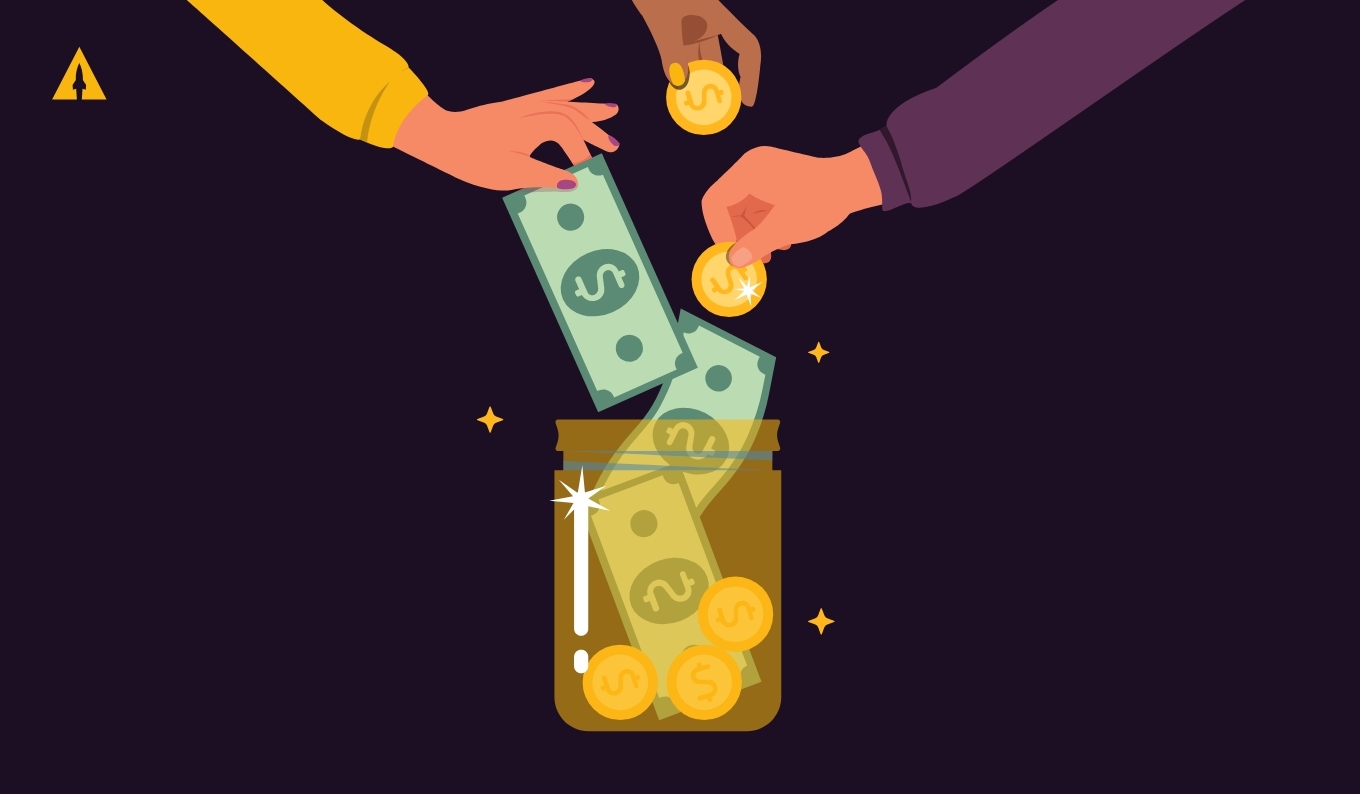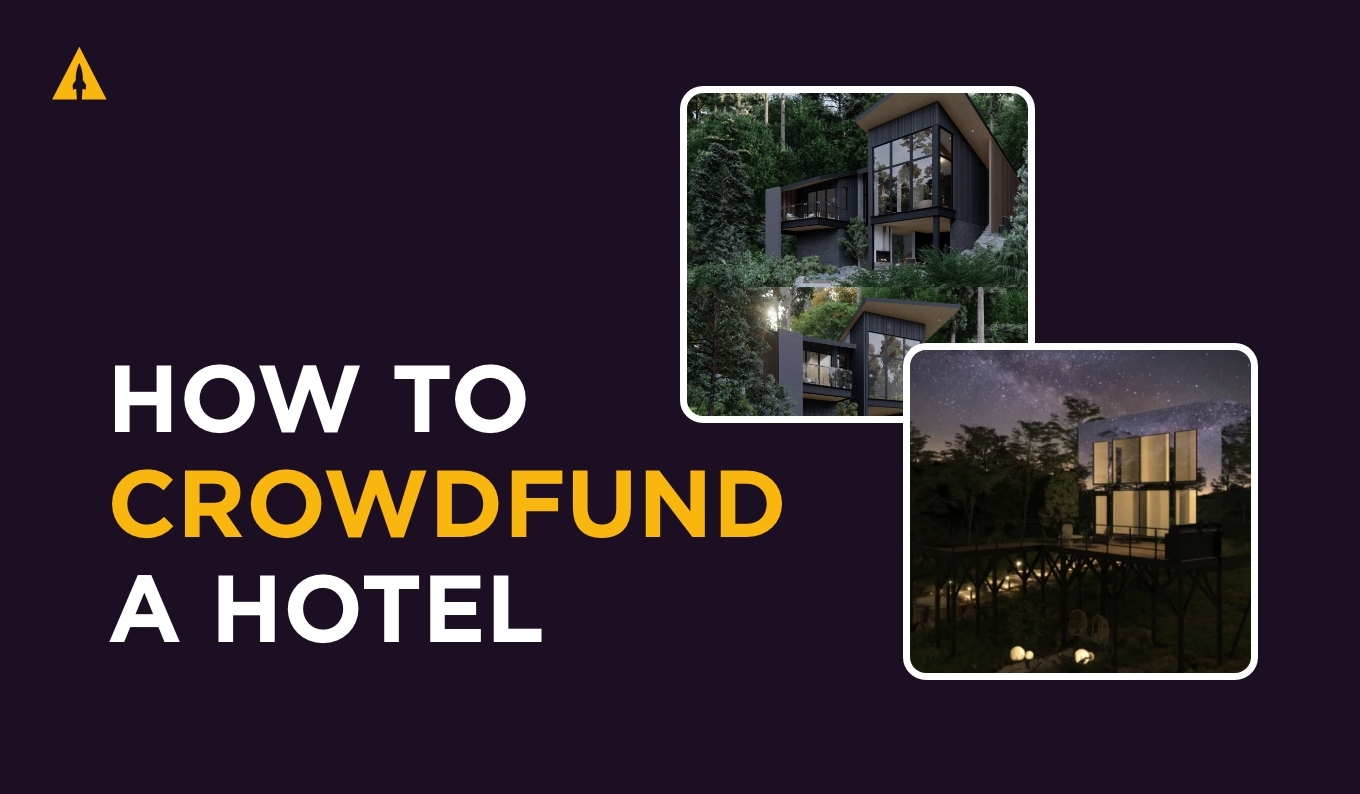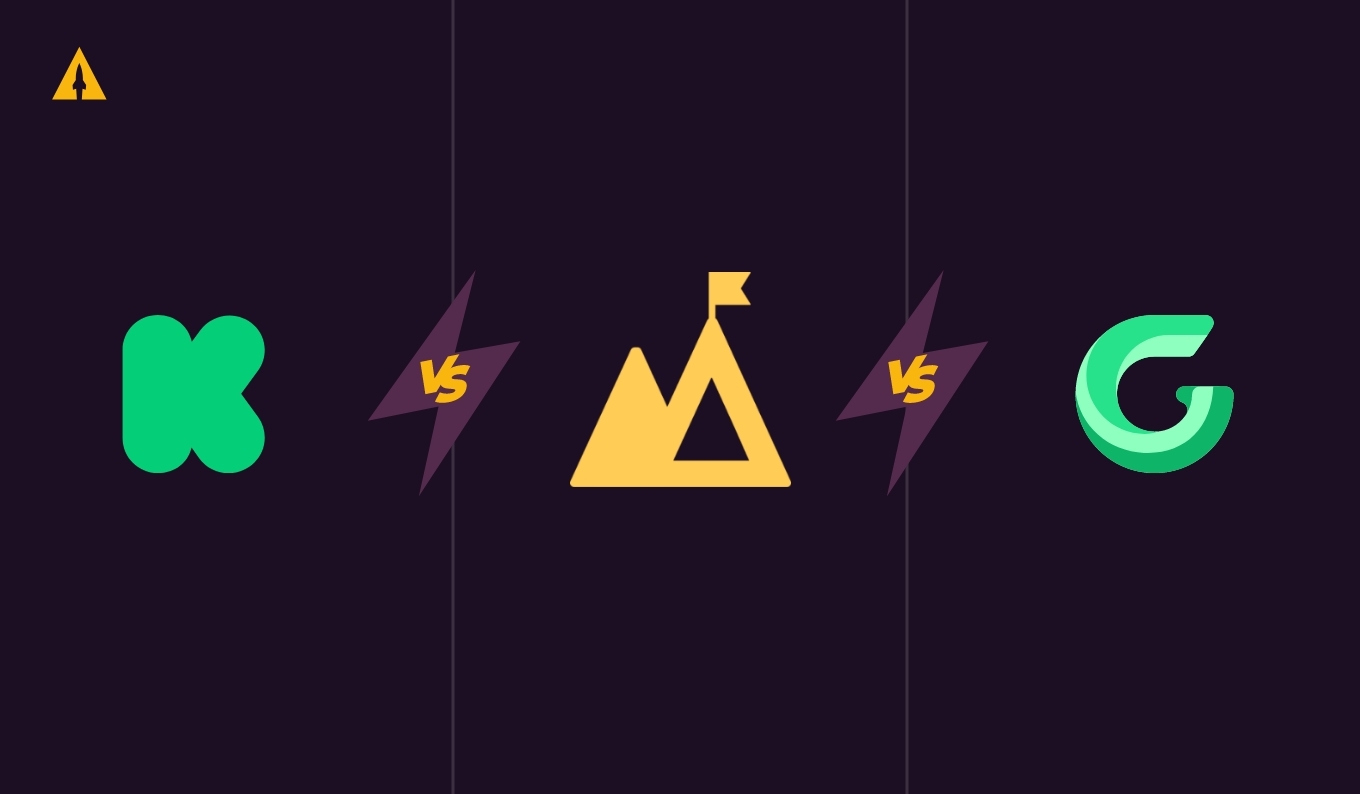
Kickstarter’s influence on tabletop gaming has been enormous. Since 2009, they’ve been bringing games to life, starting with a game that raised $1,000 to now one that raised $15M… and many, many more campaigns in between.
Tens of thousands of successful games launched, millions of people backed, and billions of dollars raised. There’s a reason why Time magazine has named it one of the top 100 most influential companies.
But over the past few years, two new crowdfunding platforms have entered the ring: Gamefound & BackerKit. Combined they’ve raised over $230M with their tabletop campaigns. When zooming in on the last year alone, BackerKit’s revenue has tripled, and Gamefound claims to now be the #1 platform for board games.

But do these claims mean that they are actually better platforms than Kickstarter? Or are they just marketing hype?
At LaunchBoom, we’ve helped tabletop game creators launch through crowdfunding for years. In 2024 alone, we helped launch 111 tabletop games, raising $24.5M—but 96% of our launches were on Kickstarter.
So this question of “which crowdfunding platform is best for tabletop games?” is something we really wanted to answer this year. It turned into a multi-month deep dive—conversations with creators, way too many spreadsheets, and compiling all our thoughts into 7 categories that we can use to compare the platforms to each other:
- Project Categories: Which types of games and projects perform best on each platform
- Community & Platform Size: The reach and engagement of each platform’s built-in audience
- Fees & Payment Methods: What creators pay and how backers can contribute
- Marketing & Promotion: Platform-specific promotional tools and opportunities
- Pre-Launch Features: Tools available before your campaign goes live
- Live Campaign Features: Functions and capabilities during your active campaign
- Post-Campaign Features: Pledge management and fulfillment tools after funding
Now we have the answer to this question, and by the end of this post, I’m pretty sure you’ll know which platform will be best for your launch.
Also, if video is more your thing, we have this whole guide in that format too. Check it out here:
Contents
- Understanding the Tabletop Crowdfunding Landscape
- Platform Origin Stories: How We Got Here
- 1. Project Categories: Which Types of Games Perform Best Where
- 2. Community & Platform Size: The Impact of Built-in Audiences
- 3. Fees & Payment Methods: What It Costs to Run Your Campaign
- 4. Marketing & Promotion: Getting Your Game Noticed
- 5. Pre-Launch Features: Setting Up for Success
- 6. Live Campaign Features: Tools During Your Active Campaign
- 7. Post-Campaign Features: Managing After Funding
- Conclusion: Making the Right Platform Choice
Understanding the Tabletop Crowdfunding Landscape
One of the first things I made when diving into this research was a chart looking at the total funding in crowdfunding per year on each of the platforms, filtered for tabletop games.
In 2024, BackerKit raised $23.1M, Gamefound raised $84.5M, and Kickstarter raised $216.6M. As you can see, the amount of funding for games on Kickstarter has been decreasing year over year since 2021. Gamefound has gone from $22M in 2021 to $84.5M in 2024. And BackerKit has also seen growth but not nearly as much as Gamefound.
What’s most notable to me about this data isn’t that Gamefound and BackerKit are taking a bite out of Kickstarter—though they certainly are—but that tabletop game funding is growing overall. 2021 was kind of an outlier because of COVID, so if we look just from 2022 to 2024, there’s been an increase in tabletop game funding of $54M.
The quote “a rising tide lifts all boats” comes to mind. But the question I want to answer now is, why are creators going to Gamefound & BackerKit, and are their campaigns actually performing better?
Before diving into that, I think a brief history lesson will help us understand why the platforms have certain strengths and weaknesses.
Platform Origin Stories: How We Got Here
What is Kickstarter?
Kickstarter was started in 2009 by Perry Chen, Yancey Strickler, and Charles Adler. They wanted a way to allow artists to bring their ideas to life by having the community decide which ones to fund. It didn’t take long for it to expand to all types of creative ideas—like tech products, restaurants, and tabletop games.
Speaking of tabletop games, that became their biggest category and still is today, making up about 28% of all funding on the platform. Kickstarter has been incredibly influential in growing the tabletop game market, being responsible for games like Nemesis Lockdown from Awaken Realms, Frosthaven from Cephalofair Games, and most recently Brandon Sanderson’s Cosmere RPG from Brotherwise Games, which raised over $15M.
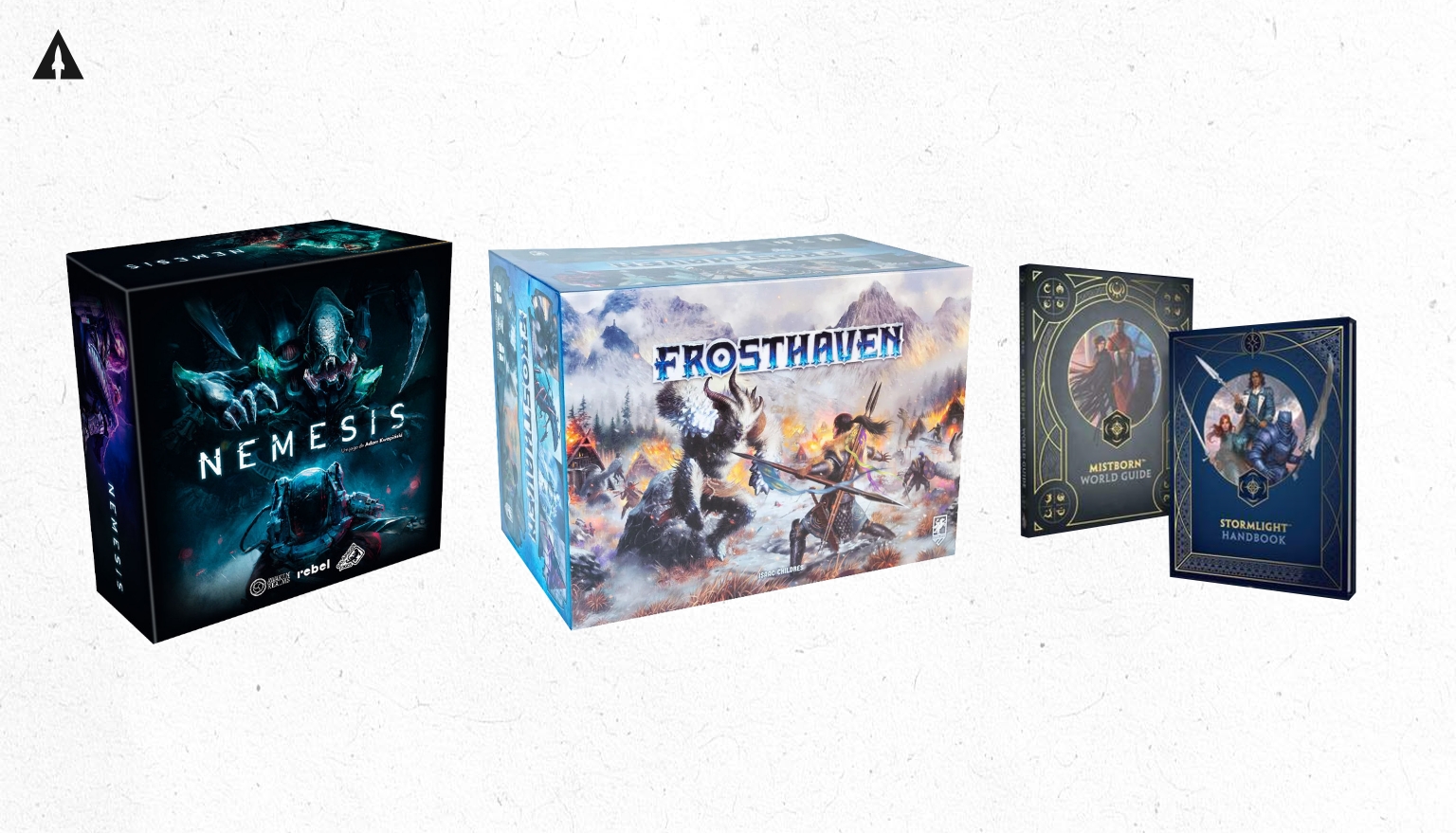
The original founders of Kickstarter aren’t part of the day-to-day anymore. In 2022, a new CEO joined—Everette Taylor, a young and accomplished entrepreneur with an incredibly strong marketing background. Kickstarter needed a new vision and leadership to help them accomplish it because competition had finally shown up.
What is Gamefound?
Gamefound started in 2016 by Marcin Świerkot and Szymon Matyjaszek. Marcin was the CEO of Awaken Realms, the board game publisher I mentioned earlier that raised millions of dollars through Kickstarter.
At the beginning, Gamefound actually wasn’t a crowdfunding platform but a pledge manager—software that makes managing the post-crowdfunding process way easier by organizing backer information and helping with fulfillment. Marcin started Gamefound mainly because he didn’t like Kickstarter’s lack of post-campaign tools and wanted better software to help them fulfill their Kickstarter campaigns.
For 4 years, they kept letting more and more tabletop creators use it, but on December 17th, 2020, they decided to evolve. They launched their first crowdfunding campaign on Gamefound for ISS Vanguard, one of Awaken Realms’ games, and raised $4.9M.
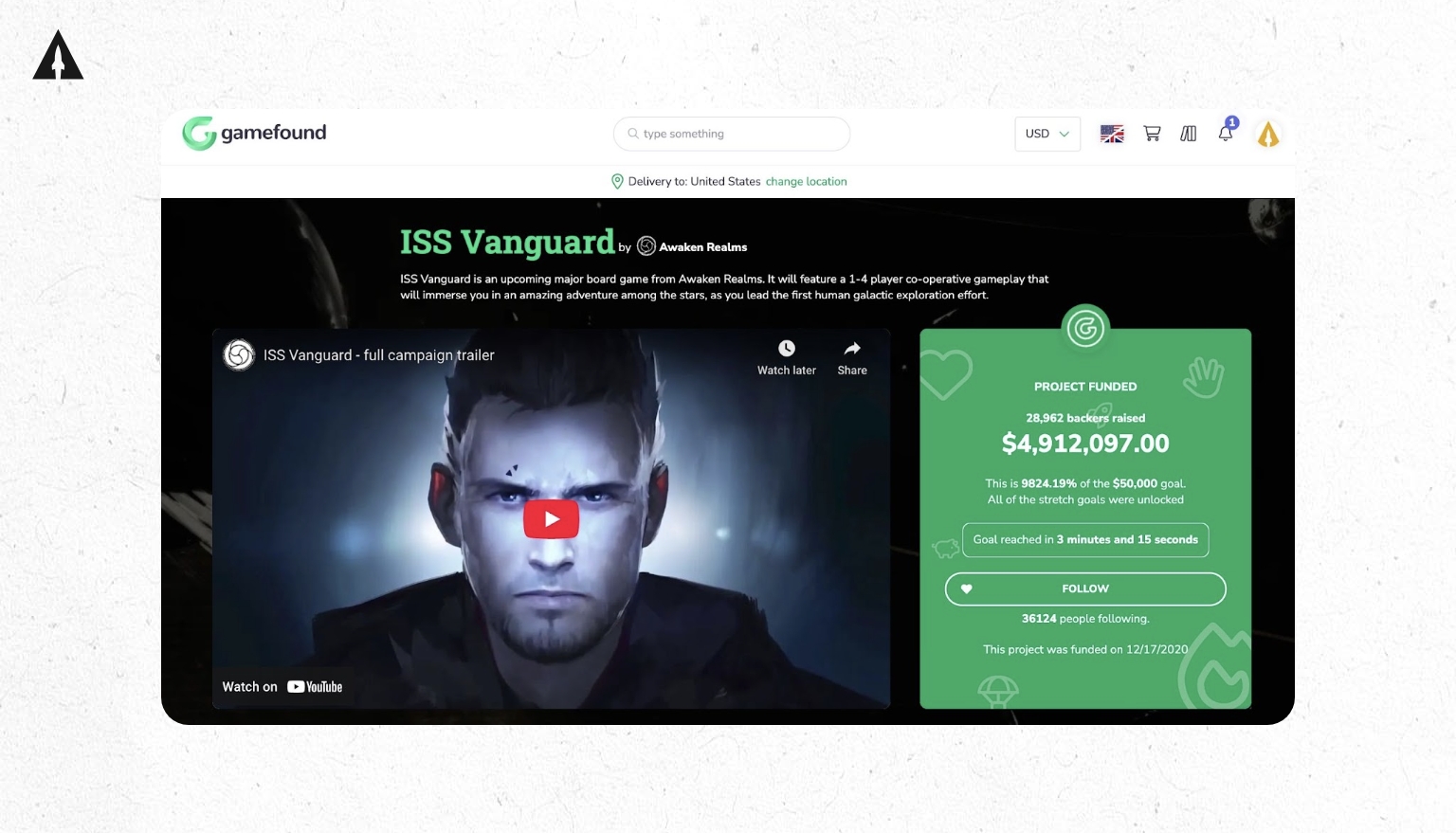
This officially kicked off their beta into being a crowdfunding platform. One of their biggest differentiators, like their brand name suggests, was that they focused solely on tabletop games.
In 2022, they officially came out of beta and started accepting more game creators. Marcin set an ambitious goal to match Kickstarter’s tabletop crowdfunding revenue by 25% in 2022. With Kickstarter bringing in more than $270 million for tabletop games in 2021, that meant his relatively new platform had to raise $67.5 million. They ended up doing $28.3 million that year, but in 2024 that number reached $84 million.
Part of the reason why they didn’t hit their goals as quickly as they wanted? Well, another new challenger had appeared.
What is BackerKit?
The founders of BackerKit, Maxwell Salzberg and Rosanna Yau, launched the first 6-figure Kickstarter project called Diaspora back in 2010. They ended up building pledge management software to help them manage their post-campaign process. And in 2012, they released that software to the public as BackerKit.
Just like Gamefound’s origin story, BackerKit was mainly focused on helping creators from Kickstarter with their post-campaign. But unlike Gamefound, BackerKit was open to all project categories. They’ve been, by far, the most successful pledge management software ever.
But in 2022, the same year Gamefound’s crowdfunding came out of beta, BackerKit’s Crowdfunding beta launched. They had over 40 creators launch that year, but they were largely focused on big tabletop game publishers. For example, one of the first launches was from Restoration Games, a publisher that had previously launched 4 successful Kickstarters, and on BackerKit their campaign raised over $2M.
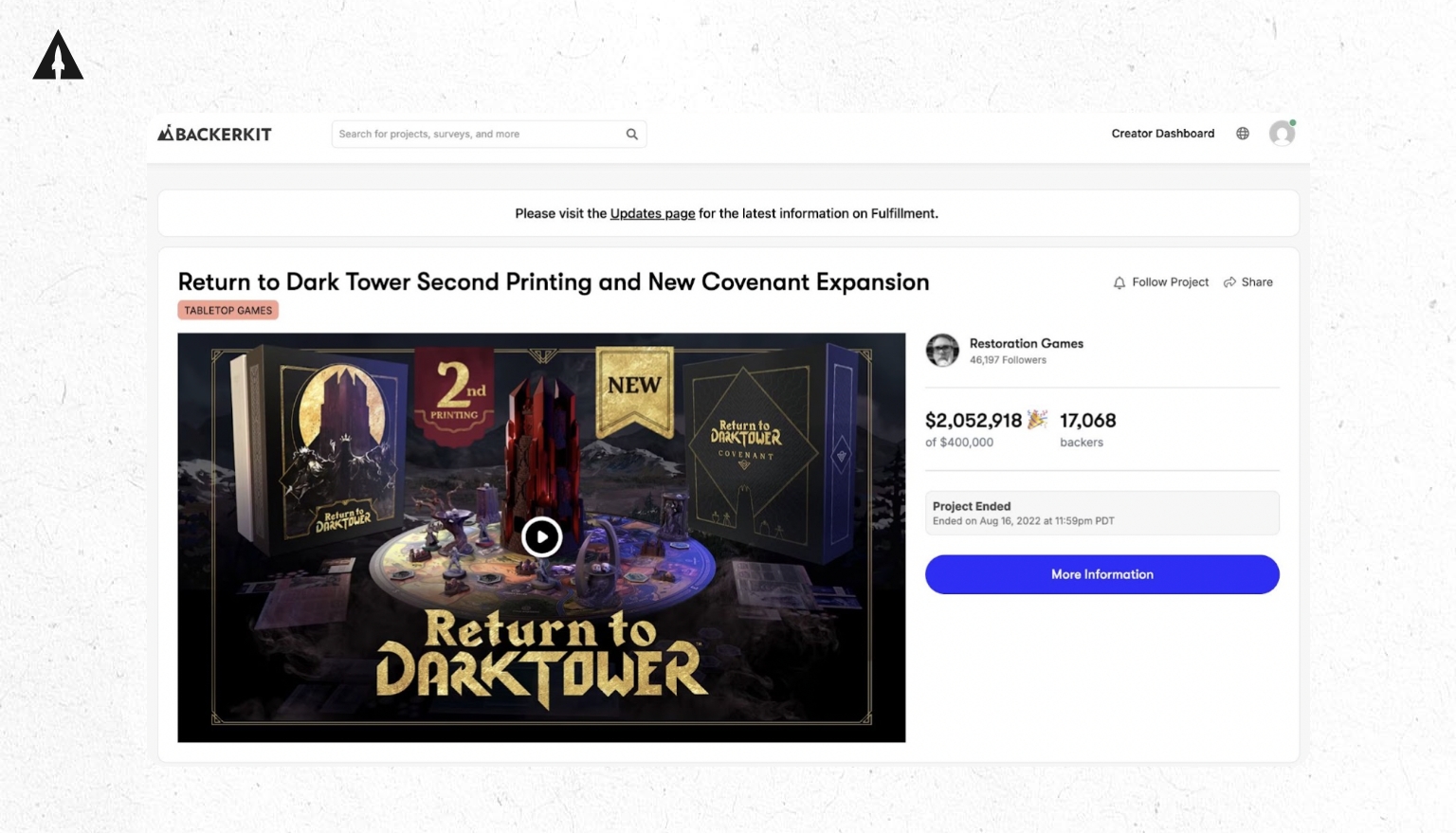
In July of 2023, they officially came out of beta and opened up crowdfunding to all.
It’s a bit wild when you think about it—BackerKit and Gamefound were created out of necessity because Kickstarter didn’t offer pledge management tools, and then those tools evolved into their own crowdfunding platforms. Kickstarter basically created their own competitors.
Now, let’s start diving into the 7 categories we’ll be using to compare the platforms. I had a lot of help getting access to this tabletop data from Konstantinos, the founder of Hive, Vesuvius Media, and Tabletop Analytics, as well as Adam Clark, the founder of Kicktraq and PledgeManager.com. So thank you to both of them for their help.
1. Project Categories: Which Types of Games Perform Best Where
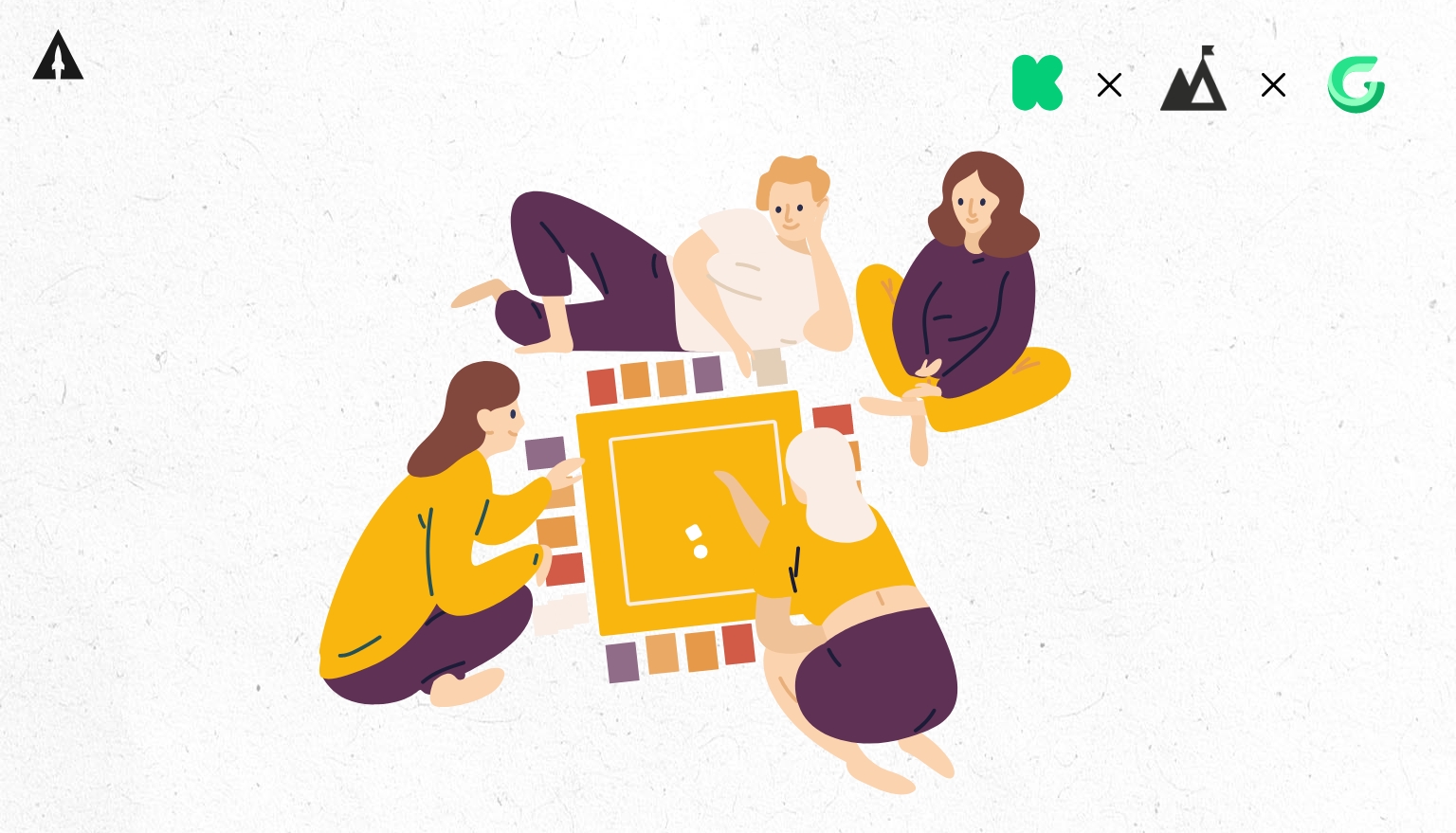
I wanted to start with project categories because I think one of the quickest ways to figure out which platform is best for you is to look at the project categories that are performing the best on each platform. I dug up a lot of nitty-gritty data, but before we get into that, I think it’s good to start with a high-level overview of all the categories on each platform, even those outside of games.
Categories Across Platforms
Kickstarter’s Wide-Ranging Approach
Kickstarter has 15 main categories and a total of 155 sub-categories. Games is the largest category, with $2.61B raised. Then it’s followed by Design & Technology, which combined is another $3.4B. The top 3 categories combined make up 71% of all the funding on the platform.
BackerKit’s Emerging Focus
BackerKit has 15 main categories and no sub-categories. Role playing games, Writing & publishing, and Tabletop Games are the top 3. But keep in mind that 1 campaign, Brandon Sanderson’s Words of Radiance Leatherbound, makes up 94% of all the funding in the Writing & Publishing category. So, the success of that category in particular is pretty skewed. Where BackerKit has really been standing out is in the TTRPG, Plushies & Toys, and Enamel Pins categories, where they’ve seen quite a lot of growth year over year.
Gamefound’s Specialized Structure
Gamefound has 52 categories and no sub-categories. Since Gamefound is only focused on board games, most of their categories are simply genres of board games. For example, unlike their competitors, they have categories that describe the type of game like strategy, RPG, or solo. But more recently, Gamefound has expanded their categories a little more by also allowing projects that aren’t games themselves but are still a part of the tabletop game ecosystem. For example, gaming tables, dice, or character sheets for D&D.
Diving Deeper into Tabletop Categories
I decided to take a look at the top 40 campaigns on each of the platforms. This gives us a more apples-to-apples comparison of which categories are performing the best. Here’s a pie chart showing the aggregate funding by tabletop category in the top 40.
As you can see, board games and RPGs are the biggest categories by volume across all the platforms. Let’s take a look at RPGs first.
RPGs: A Tale of Two Platforms
We can see that Gamefound doesn’t have any RPGs in its top 40 campaigns, so let’s focus on Kickstarter and BackerKit.
RPGs is BackerKit’s biggest category and has had the most meaningful growth since they launched – doing over $19M in 2024.
But even though RPGs only make up 22.5% of the top 40 campaigns on Kickstarter, they’re still launching lots of RPGs too.
In 2024, Kickstarter launched RPGs like Brandon Sanderson’s that did $15M, and if we zoom out to all the RPGs, they raised $62,475,927 from 1,431 projects.
So, yes, Kickstarter has been more successful with RPGs from a numbers perspective, but BackerKit is making some moves, and I wouldn’t say the choice on which platform to choose is clear by looking at the data I just shared.
Board Games: Kickstarter vs. Gamefound
In 2024, the tabletop category on BackerKit, which is basically their board game category, dropped off substantially – going from $8.2M in funds raised in 2023 to $4M in 2024.
The data shows that most creators have been choosing either Kickstarter or Gamefound when it comes to board games.
So let’s look at the top 40 board game campaigns on Kickstarter and Gamefound next. I’m going to pull up some aggregate metrics.
For Kickstarter, the top 40 board games:
- raised $46,639,858 in total
- had an average funding of $1,165,996
- and had a median funding of $973,266
I like looking at the median because it helps to weed out some of the outliers in the data which may skew the averages up.
For Gamefound, the top 40:
- raised $65,070,573 in total
- had an average funding of $1,626,764
- and had a median funding of $829,806
Here’s a table so you can see the info side-by-side:
| Kickstarter | Gamefound | |
| Total Raised | $46,639,858 | $65,070,573 |
| Average Funding | $1,165,996 | $1,626,764 |
| Median Funding | $973,266 | $829,806 |
This might make it look like Gamefound is outperforming Kickstarter quite a bit when looking at the top 40 campaigns (except for the median funding). But I wanted to go a little deeper.
Big Creators and Platform Concentration
Let’s look at what percentage of the total funding on each platform the top 40 campaigns make up. This gives us a good idea of how much the platforms rely on big campaigns.
On Kickstarter, that $46M in total top 40 board game funding makes up 21.53% of their total tabletop funding, which was $216.6M.
On Gamefound, that $65M makes up 77.01% of all the funding, which was $84.5M.
| Kickstarter | Gamefound | |
| Top 40 Total Funding | $46.6M | $65M |
| Total Tabletop Funding | $216.6M | $84.5M |
| Top 40 % of Total Funding | 21.53% | 77.01% |
That’s right—just 40 campaigns make up 77% of all the funding on Gamefound in 2024. But it gets even more interesting. I started noticing that the same creator names kept showing up on the top 40 list for Gamefound.
- Chip Theory Games launched 3 campaigns, all in the top 40, and raised $3,639,035
- Archon Studio launched 4 campaigns, 3 in the top 40, and raised $8,125,841
- CMON launched 6 campaigns total, 4 in the top 40, and raised $12,170,261
- Awaken Realms (who are the owners of Gamefound) launched 5 campaigns total, with 4 campaigns in the top 40, and raised $17,040,812
So just these 4 creators make up 48.5% of all the crowdfunding funds raised on the platform in 2024.
Remember, on Kickstarter, even if you take the entire top 40 board game campaigns which represent 35 separate creators, it only accounts for 21.5% of all the tabletop game funding.
Gamefound’s Strategy and Results
Gamefound really relies on large established creators to boost their numbers up, and it makes sense. Gamefound has been pretty public about their strategy of going after large creators and making deals with them. Last year they struck a deal with CMON to exclusively launch their projects on Gamefound, and in my conversations with creators, I’ve heard of many more deals being offered to Kickstarter creators to move to Gamefound—stuff like offering to lower the platform fee or even pay for ad spend.
Their business strategy seems to be:
- Attract established creators to Gamefound by offering really good deals
- Have those established creators boost the total funding numbers
- Use that as marketing content to attract less established creators to Gamefound
So when you see a headline from Jamey Stegmaier saying how Gamefound is the biggest crowdfunding platform for board games, you can see their marketing plan in action.

It makes strategic sense because Gamefound is launching so many fewer campaigns than Kickstarter. In 2024, 300 campaigns launched on Gamefound with 220 of them being successful, which is a 73% success rate, while Kickstarter launched 6,646 with 5,314 being successful, which is an 80% success rate.
I don’t think big raises from big established companies on Gamefound are really the best guidepost in helping us answer the question of which platform is better, since those campaigns would have probably done at least equally as well on Kickstarter.
There’s this quote from Marcin, the CEO of Awaken Realms and Gamefound, from 2022 in a Polygon article, but I think it still applies today: “I’m 100% convinced this [success is due to] the games and the publishers behind them, The [intuitive design of the] platform might help a little bit, […] but I’m sure that on Kickstarter they would have also been very successful.”
Experience Level of Creators
If we dive even deeper into the data, we see that 95% of the top 40 board game campaigns on Gamefound have launched previous campaigns and 92.5% have previously launched Kickstarter campaigns, with the average number of previous Kickstarter campaigns launched before coming to Gamefound being 13.
My point—based on this, I think it’s safe to say that the vast majority of funding on Gamefound is not coming from beginners, and those established creators that launched on Gamefound would have been successful on Kickstarter.
But what about Kickstarter? Are the top 40 campaigns a mix of newbies and veterans? Well, 80% of the top 40 board game creators had launched previous projects so most are not newbies, but Kickstarter had 8 first-time creators in the top 40 vs. 2 on Gamefound, which is a pretty big difference. Plus, the top board game on Kickstarter in 2024 was the first-time creator Factory Fortress who raised $3.3M.

Furthermore, if we compare the total funding from first-time creators in the top 40, we see that Kickstarter first-time creators raised $8.3M while Gamefound raised $1.2M.
Game Subcategories and Performance
Gamefound’s big numbers may look enticing, but when we look a little deeper we see that they’re boosted from big established creators, with 4 creators making up almost 50% of all the crowdfunding funds raised on the platform. And if we look at Kickstarter, we see 4 times more first-time creators in the top 40 than Gamefound. But I was still curious to know if there are specific genres of board games that seem to be performing better on each of the platforms.
For each of the top 40 games, we further categorized them into 6 sub-categories:
- Heavy Strategy
- Medium Light Strategy
- Co-op
- Campaign
- Miniatures
- Cozy & Cute games
Now we can do a more apple-to-apple comparison looking at how these different sub-categories performed on each platform.
Some of the more notable categories to look at are the following:
On Gamefound, sub-categories loved by more hardcore game hobbyists seem to outperform Kickstarter in terms of total and average funds raised. For example, Co-op, Campaign, and Miniatures games.
On the other hand, Kickstarter seems to cater to games with more broad appeal, and sub-categories like Heavy Strategy, Medium Light Strategy, and Cozy & Cute outperform Gamefound.
So, if you’re a creator and you have a game that caters to a more “hardcore game hobbyist,” plus you’re a veteran creator, you may want to launch on Gamefound. And if you’re outside of those categories, and especially if you’re not a huge established creator, Kickstarter may be the right one.
But the question now becomes… why? Why does sub-category or a creator’s crowdfunding experience really matter when it comes to the platform? Well, that’s a good segue into the next category: Community & Platform Size.
2. Community & Platform Size: The Impact of Built-in Audiences
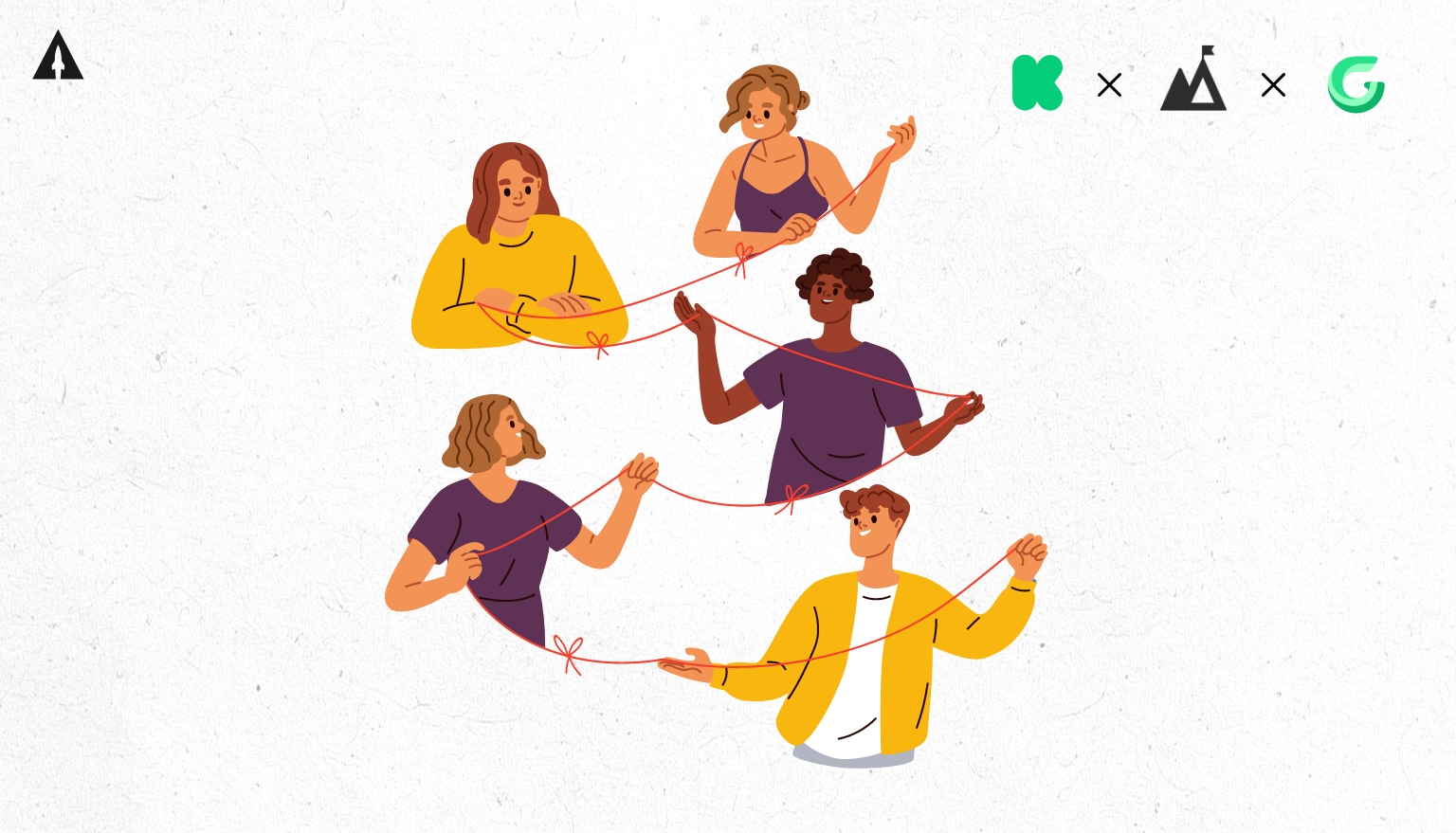
Launching a crowdfunding campaign is basically the same as launching a pre-order for your product. So why not just launch your product on your own e-commerce website? I mean, it’d be completely doable with modern e-com platforms like Shopify.
There are quite a few reasons why crowdfunding platforms work better for a pre-order launch, but there’s one difference that I think really stands out: the crowdfunding platform’s community.
If you launch your pre-order on your own website, the only way people will find you is if you drive traffic yourself. But if you launch on a crowdfunding platform, you can tap into their built-in communities which will drive revenue for your launch. So figuring out how big of an impact the communities of each of the platforms have on a campaign is pretty important.
Sizing Up the Platforms
Any way you look at it, Kickstarter is the biggest platform, period. It has more funding, more projects, more traffic, etc. It makes sense—it’s been around a lot longer than Gamefound and BackerKit. But how much bigger is it exactly?
The data on Kickstarter’s website says they have 23,757,512 backers. Gamefound has over 1.3 million. And BackerKit has over 750K.
But is larger necessarily better…? Maybe.
Let’s break it down.
What I want to do first is try to understand how much funding for a campaign typically comes from each platform’s community.
I want to preface this by saying that the info I’m about to share doesn’t tell the full story because I don’t have access to all the data from every launch on each platform, but I still think the data and experiences I will share offer insight.
Kickstarter’s Community Impact
First, we’re going to look at data from a couple of first-time creators on Kickstarter that we worked with at LaunchBoom. The reason why I’m choosing first-time creators is because the platform size matters the most for these types of creators since established creators already have their own communities they can tap into for their launches.
Let’s look at Pantheum by Trevor Kerth. His launch on Kickstarter raised $288,619.

Kickstarter claimed attribution on $65,982 of the funds raised, which means that 22.86% of all the funding came from Kickstarter. Also know that I excluded “Kickstarter Search” from that number because if someone searched for Pantheum, they would have had to have heard about it somewhere else and it shouldn’t be attributed to Kickstarter.
For the second campaign, let’s take a look at Sugarpow by Fancymelon Games, another first-time creator. They raised $53,437 – while lower than Pantheum, it’s still a lot of money, especially for a first-time publisher.

Using the same filters as before, in total, Kickstarter drove $15,370 in additional sales or 28.76% of all the funding. It’s pretty impressive to have such a large percentage of the campaign funding come from Kickstarter.
I also looked at an example of an established creator launching on Kickstarter—Hit Point Press and the project we worked on called Field Guide to Floral Dragons, a TTRPG campaign which raised $1,163,164.
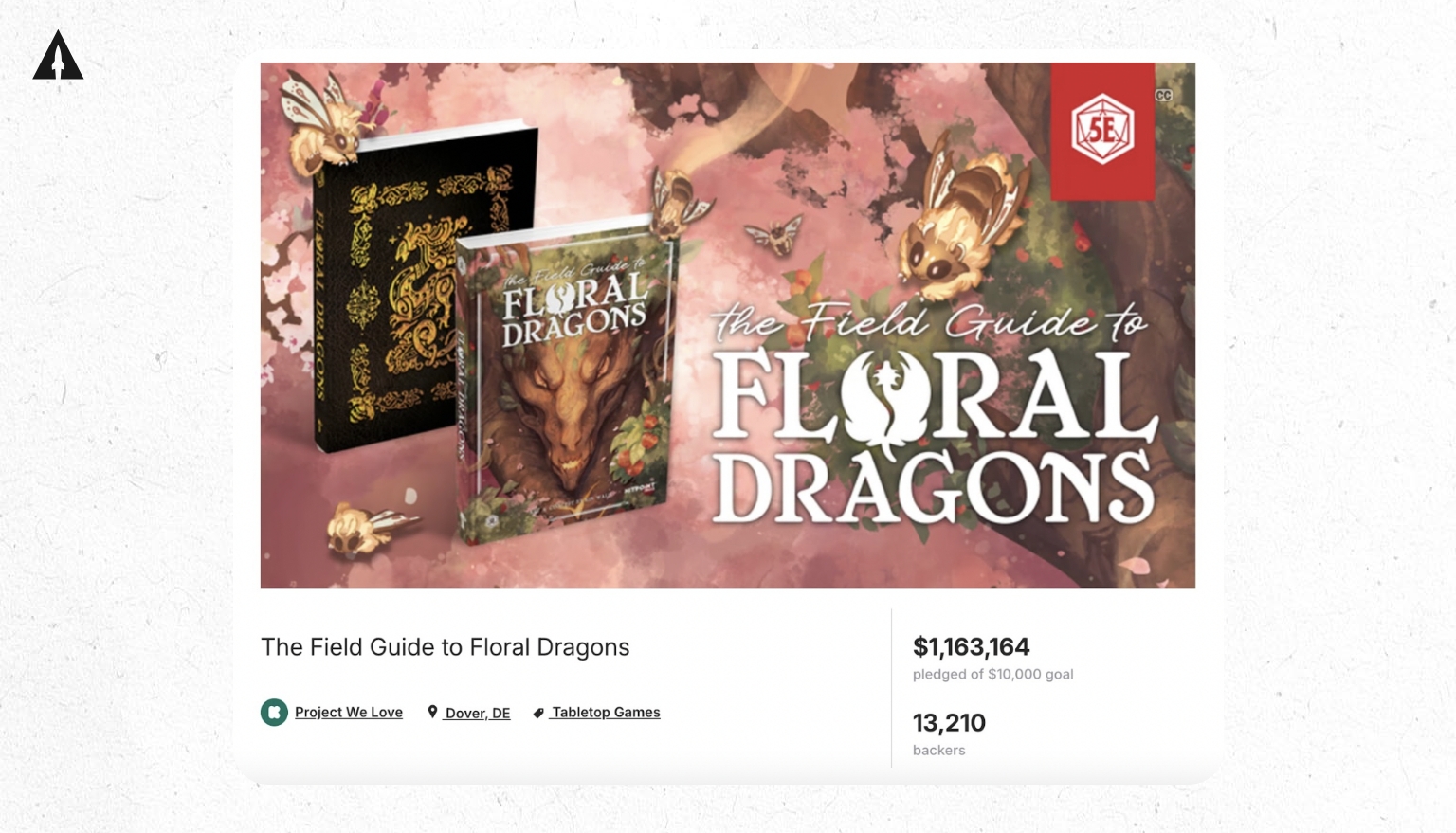
Before launching this campaign, they had already launched 15 campaigns, so their community was already pretty big. So how much did Kickstarter drive to this campaign?
$226,495 or 19.47% of their total campaign funding. So it was a lower percentage than the two first-time creators that I shared, but still pretty high.
It seems like the discoverability on Kickstarter can be pretty good, even for campaigns with huge audiences.
BackerKit’s Discovery Power
Now we have a lot less direct experience working with BackerKit’s crowdfunding platform. But I found this reddit thread from the creator Inkwell Ideas who has launched 21 Kickstarter projects and has now launched 2 BackerKit projects. This thread breaks down the data from their latest campaign that raised $93,560. According to his breakdown, BackerKit discovery brought in about 4% of all the funding or $3,742.

Then there’s this other reddit thread asking for advice on choosing between Kickstarter & BackerKit. The top commenter said this: “Kickstarter if you have no audience, Backerkit if you bring the audience. That’s basically the way I’ve seen it play out. Kickstarter has people that browse Kickstarter just to find games and will bring you 1/2 or more of your audience up to a certain point (let’s say about $25,000 just as a point of reference). Over that, Kickstarter’s audience has less of an effect and keeping everything (pre/post-campaign) streamlined within Backerkit is more worth it.”
So it seems like it’s common knowledge that Kickstarter will likely drive more traffic organically, but still, some RPG creators are choosing to launch on BackerKit and finding success. There must be something else that’s driving them to BackerKit, but more on that later.
Gamefound’s Audience Dynamics
There’s a pretty big thread on reddit on r/boardgames asking about Gamefound vs. Kickstarter. I like the thread because people look at the two platforms from the frame of the backer and the creator.
The top comment was this: “From a backers point of view, imo it is gamefound. The website has better ui, the integrated pledge manager is easier to use, and pages support YouTube videos (kickstarters player SUCKS). However, a project being of kickstarter vs gamefound is not nearly enough of a reason to back or not back a game.”
So from this comment, it seems like even though backers appreciate certain features on Gamefound more, there’s very little loyalty to the platforms themselves. Instead, they have loyalty to the publishers, and if it’s a new publisher, they evaluate the game on its own, not the platform it’s launching on.
Another comment in this thread is from the publisher Asterisk Games who launched Railways of the Lost Atlas on Kickstarter and raised $98,893. They said: “Kickstarter is far better for small/new publishers. If you look at gamefound and backerkit the only campaigns that did really well were run by established companies who brought their own fanbase to the platform with them. Maybe eventually you will see better results for small companies but at this point I think the choice is still kickstarter. I think you just get a lot more people stumbling onto your project from random traffic on the site.”
The sentiment online about Gamefound and its discoverability seems pretty similar to BackerKit—it tends to not be as good as on Kickstarter because of the limited size of the community and traffic.
The Value of Platform Diversity
I’ve heard a lot of “well Gamefound must be better for games because they are only focused on games.” But I actually saw this article on Polygon recently about Kickstarter with a quote from their Director of Communications who said, “70% of all backings to Games projects in 2024 came from backers who also supported projects in other categories like Design & Technology, Comics, and Publishing.”
With Gamefound being specifically focused on games, they tend to attract a more hardcore game hobbyist. But because Kickstarter’s platform is more diverse in terms of categories, it naturally attracts more backers from various interests and industries, like tech, design, art, comics, graphic novels, etc.
This can be a huge opportunity for game creators, as projects on Kickstarter are often discovered by people who weren’t initially looking for a game but are intrigued by unique game concepts. If your game has crossover appeal (like strong artistic elements, a thematic twist, or a narrative component), Kickstarter’s diverse backer community could really boost visibility and funding for your game.
For example, a game like Aspens, which raised over $500K with 31.46% coming from Kickstarter’s community. Or a game like Peaks, which raised over $198K with 33.32% coming from Kickstarter.
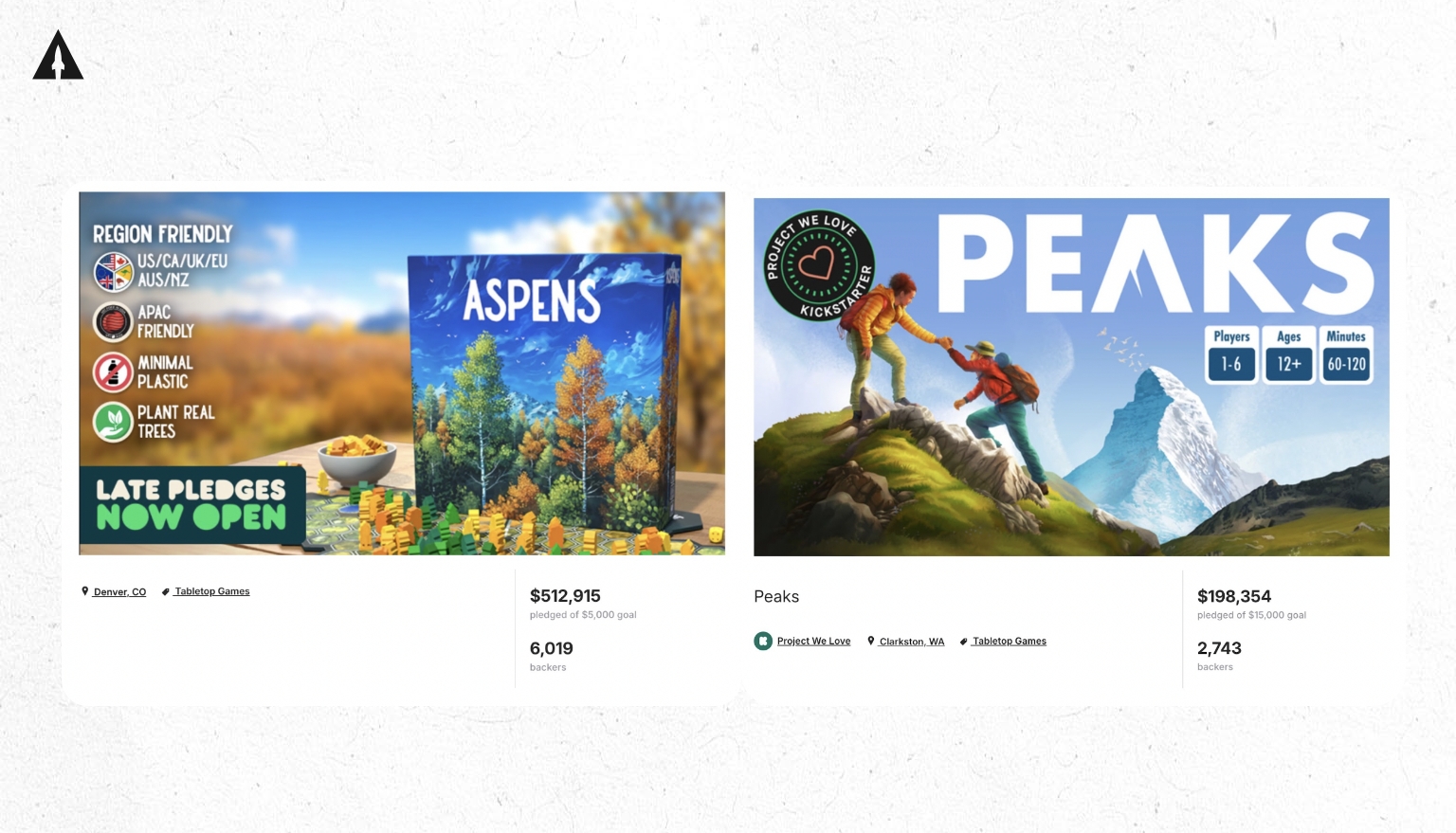
People who like board games also like other stuff too. So of course, having other categories on a platform is going to indirectly help game creators get their campaigns in front of more people.
The Platform Decision: Community Impact
From this analysis, it seems like discoverability on Kickstarter is probably better than Gamefound and BackerKit in most cases and can drive significant funding—especially if you are not an established creator.
If you’re in the RPG category, that may be changing in BackerKit’s favor. Or if you’re in the Co-op, Campaign, and Miniatures categories on Gamefound, but in general, Kickstarter seems to be less risky for a more diverse set of game creators.
3. Fees & Payment Methods: What It Costs to Run Your Campaign

First, let’s get through the more straightforward but still important topics, starting with the aspects that are similar across platforms.
All three platforms have an “all-or-nothing” crowdfunding model, meaning if the creator doesn’t hit their goal, then no funds are taken from the backer and given to the creator. If the campaign does fund, on all three platforms, the backers’ credit cards are charged when the campaign ends.
Platform Fees Breakdown
The fees they charge creators are all basically the same. Here’s how it breaks down:
- Platform Fee: Each charges a 5% platform fee on any funds raised. That’s how the platforms make money.
- Payment Processing Fees: Their payment processors take 3% + $0.30 per pledge (or $0.20 if you’re Gamefound).
- Special Cases: On Kickstarter, if a pledge is under $10, then there’s a discounted micropledge fee of 5% + $0.08 per pledge.
Payment Methods & Options
In terms of payment methods, Kickstarter & BackerKit both use Stripe to process funds, so the payment methods available are the same. Gamefound offers the same methods as Kickstarter & BackerKit but also notably has PayPal as an option plus several other regional payment methods.
Gamefound’s Innovative Payment Features
Gamefound has two distinctive payment features that set it apart:
Stable Pledge Program
Gamefound offers what they call a “Stable Pledge” – a program that every creator can join that offers backers a full refund if specific conditions are met. Here are those conditions:
- If the creator changes the price estimates (like shipping costs) at any point after the campaign ends by more than 10%, backers affected will have 2 weeks to request a 100% refund.
- If a backer refunds, Gamefound will refund its 5% fee to the creator.
Stretch Pay
Gamefound also has an option called Stretch Pay, where creators can choose to let backers break down their payments into installments. The minimum amount to trigger Stretch Pay and the number of installments is completely customizable by the creator.
For example, let’s say that you have a reward that is $200 and you allow Stretch Pay in 4 installments. Backers will pay the first installment of $50 during the campaign and then $50 three more times over the next 3 months.
It’s important to keep in mind that Stretch Pay is not the same as typical Buy Now, Pay Later options like Klarna or Affirm, which are basically loans. With something like Affirm, the creator would get all the money upfront from Affirm and the backer would pay back Affirm directly, but that’s not what’s happening here.
Backers are breaking up their payment to the creator directly, which means that there’s a strong likelihood that some percentage of backers who choose Stretch Pay won’t complete the installments, which is something to keep in mind. Still, it’s a really interesting innovation that is very popular with backers.
BackerKit’s Pay Over Time
BackerKit also has a Stretch Pay option but calls it Pay Over Time. Creators who opt-in to Pay Over Time will allow backers to break up their payments on any pledge over $150. The backers’ pledge will be paid out over four months after the campaign. So basically the same as Gamefound but a little more restrictive.
Kickstarter’s Recent Addition
Up until recently, Kickstarter didn’t have a similar payment feature. But they just announced their own pay-over-time feature called Pledge Over Time. Like the other platforms, it breaks the pledge into 4 payments. But where it differs is that the additional payments will be collected every 2 weeks instead of every month.
So all the platforms basically operate the same when it comes to the fees they charge to creators, but offer some different payment methods to backers. They all have a pledge over time feature, and Gamefound is the only one with the Stable Pledge feature.
4. Marketing & Promotion: Getting Your Game Noticed

This category specifically looks at the marketing and promotional opportunities offered by each of the platforms. These can be broken down into three sub-categories:
- Performance Marketing
- Featured Placements
- Newsletters
Performance Marketing
Performance marketing is where the platform’s marketing team will advertise your campaign and be paid when they get you a sale. All three platforms have performance marketing services, and I’m not going to comment on the actual performance—that’d be a good thing to ask them directly. But what I can comment on is how their offer works.
Kickstarter Performance
Kickstarter Performance supports creators during their pre-launch and live campaign phases and bills a percentage of revenue directly attributed to their advertising. Their service also includes creative asset production for live campaign ads at no cost to the creator.
BackerKit’s Competitive Offer
BackerKit has probably the most competitive offer. They cover all the ad spend and charge 15% of pledges directly attributed to their efforts, plus the amount they spent on ads during the campaign for repayment. Creators that go with BackerKit don’t have to pay them back until they get the funds from their campaign.
It’s interesting to note here that BackerKit’s performance marketing is not exclusive to those that launch on BackerKit. Mefaning you can launch on Kickstarter and still apply to work with them.
Gamefound’s AdFound
Gamefound also has performance marketing and charges 10% of the revenue that comes from ads, but they also just announced a new feature called AdFound.
This is a tool that allows creators to run Facebook and Instagram ads from their Gamefound account. To use it, you’ll upload ad imagery and copy, set an ad budget, and then the ads will run from Gamefound’s ad accounts. This is important to note—the ads will not be running on the creators’ account.
Creators can use AdFound if they have at least 500 followers on their project. But how much does it cost? Well, if a creator uses AdFound during the pre-launch to collect followers, there is no charge. And if a creator uses it during the live campaign to collect backers, there’s a 5% fee on pledges from those ads.
So overall, it sounds like a really cool concept, but since there hasn’t been much publicized about it yet, we’ll have to wait and see how well it actually works.
Featured Placements
Featured placements are spots throughout the website which get more visibility.
Kickstarter’s Featured Spots
On Kickstarter, they have featured placement on the homepage and category menus.
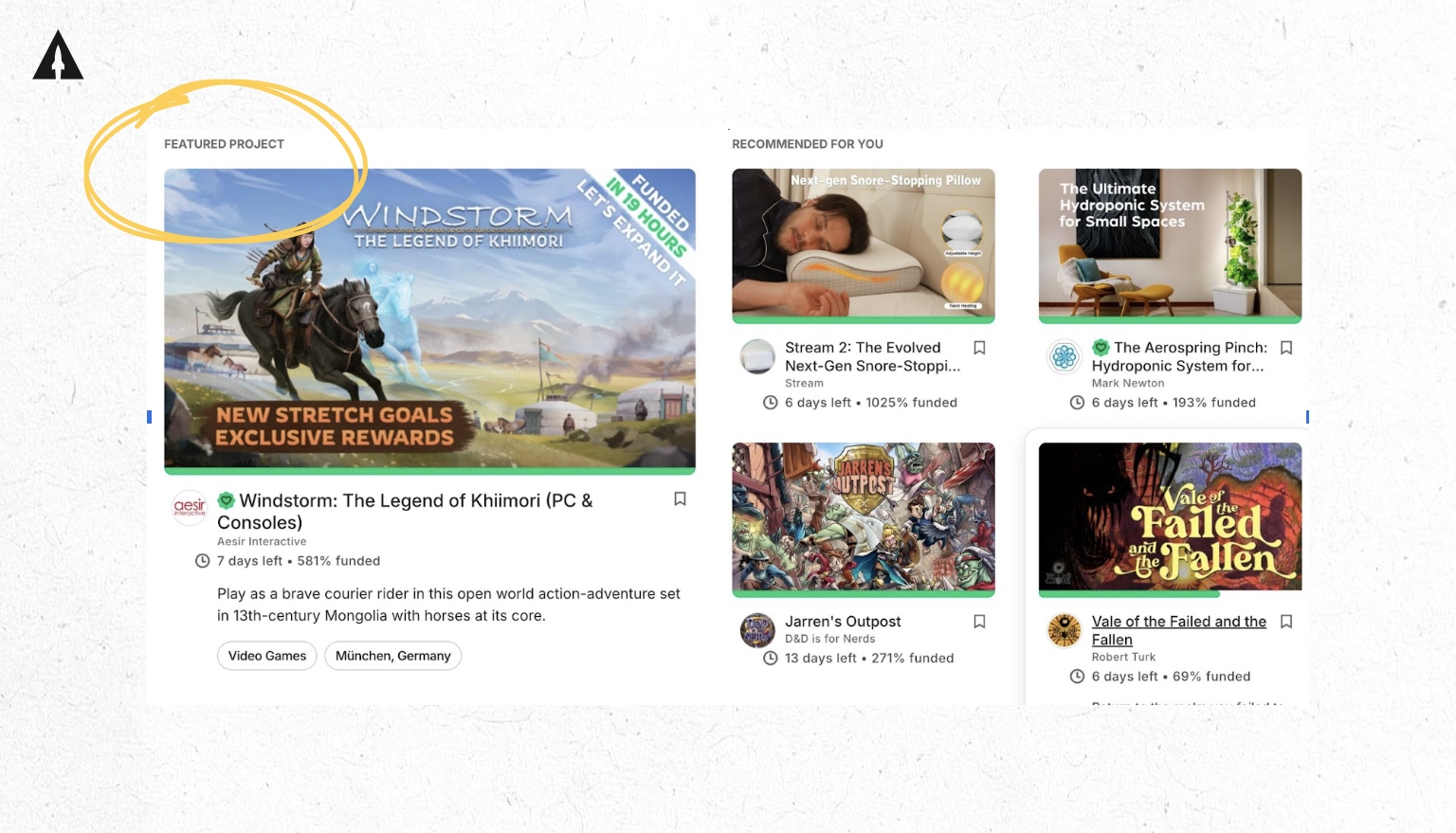

They also have something called Projects We Love. This is where Kickstarter highlights certain campaigns that, like the name suggests, they “love.”
For example, here’s one of the campaigns we helped launch called StarDriven that got the badge:
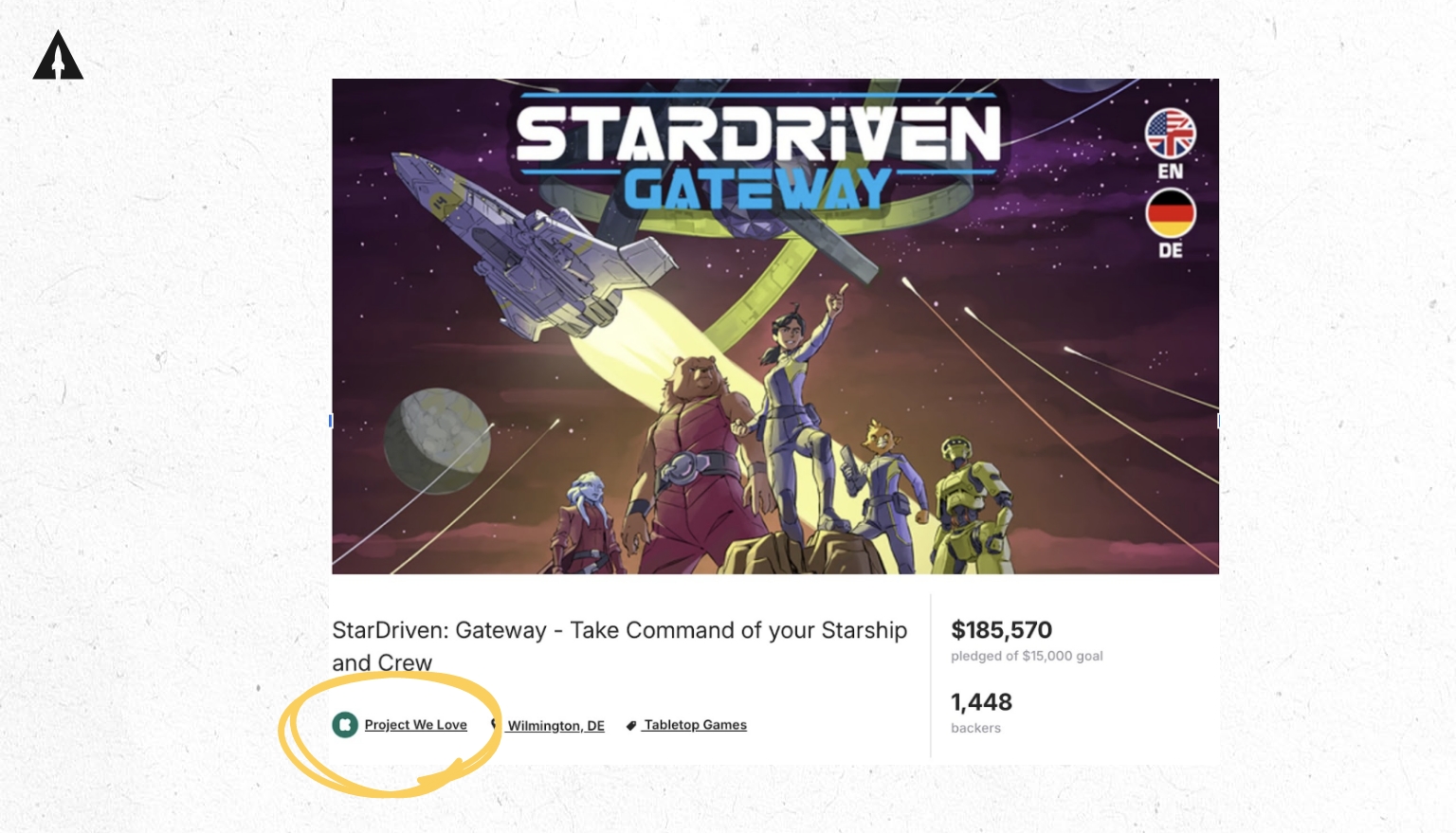
Getting that badge not only boosts credibility of your campaign but also gets you better placement in the listings.
How much does it cost to get these placements? Nothing.
Which is good and bad depending on how you look at it. Kickstarter’s team makes the call on who gets what placement, and there’s no way to pay your way in.
Gamefound’s Placement Options
Gamefound has featured placements on their homepage and a top banner that’s visible on every page.
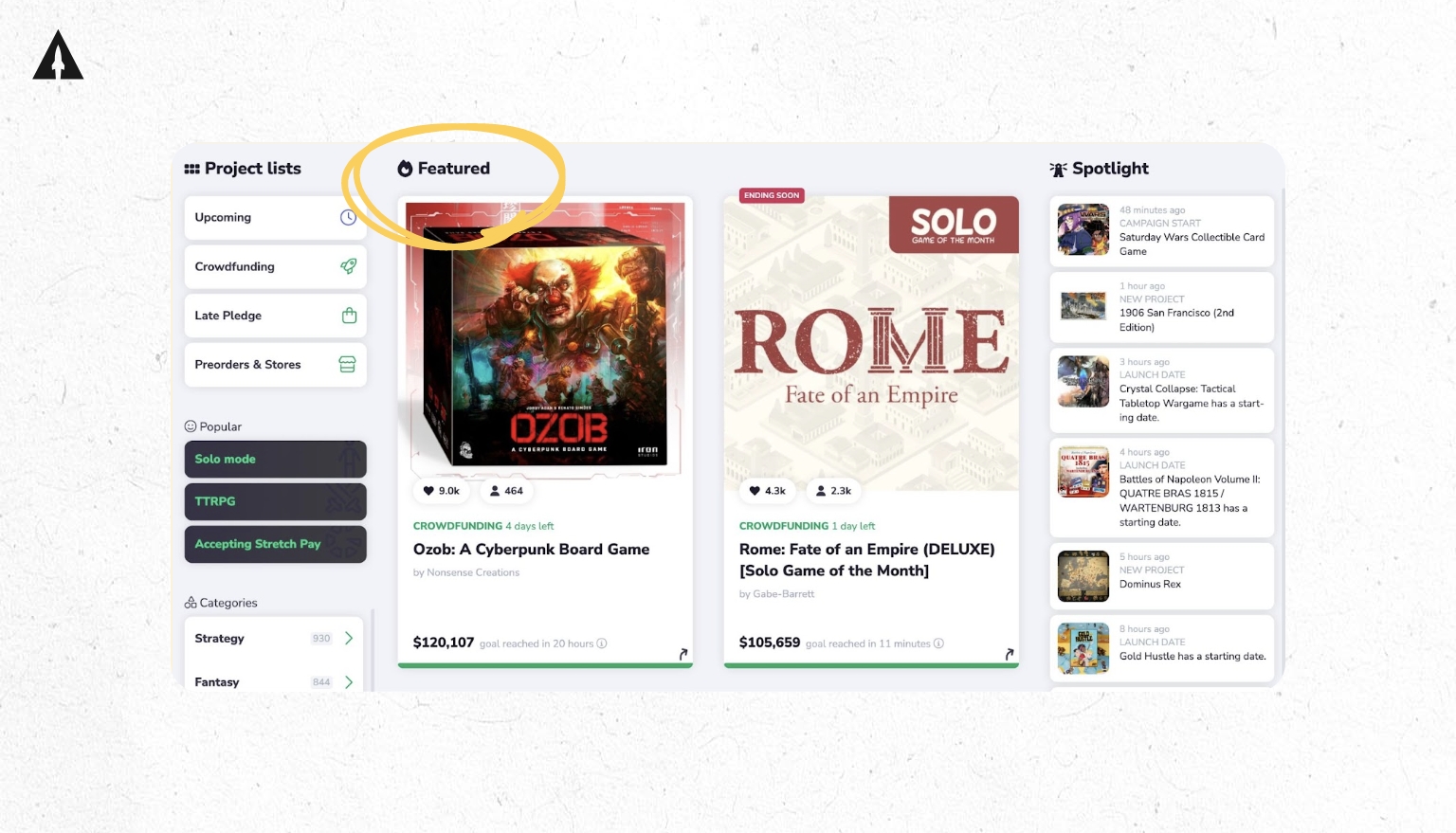
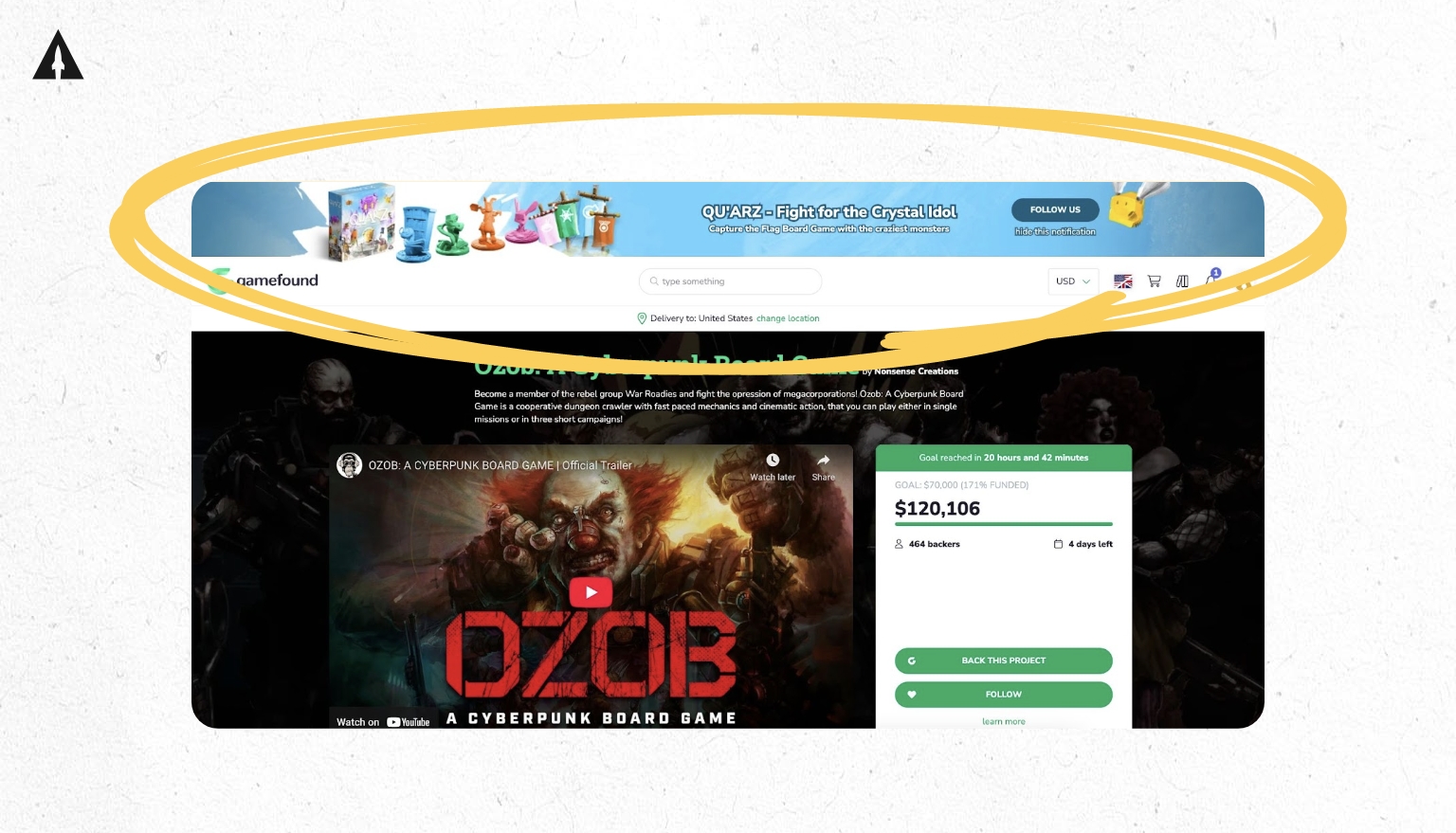
I’m not sure about the homepage placement, but the top banner seems to be something that can be paid for. There’s a help article that says “One of the ways to promote your campaign is by displaying an ad at the top of Gamefound’s website. Please contact us if you’re interested in such advertising.”
BackerKit’s Approach
It looks to me that the only featured placement is on BackerKit’s homepage, and I believe it’s just based on popularity.
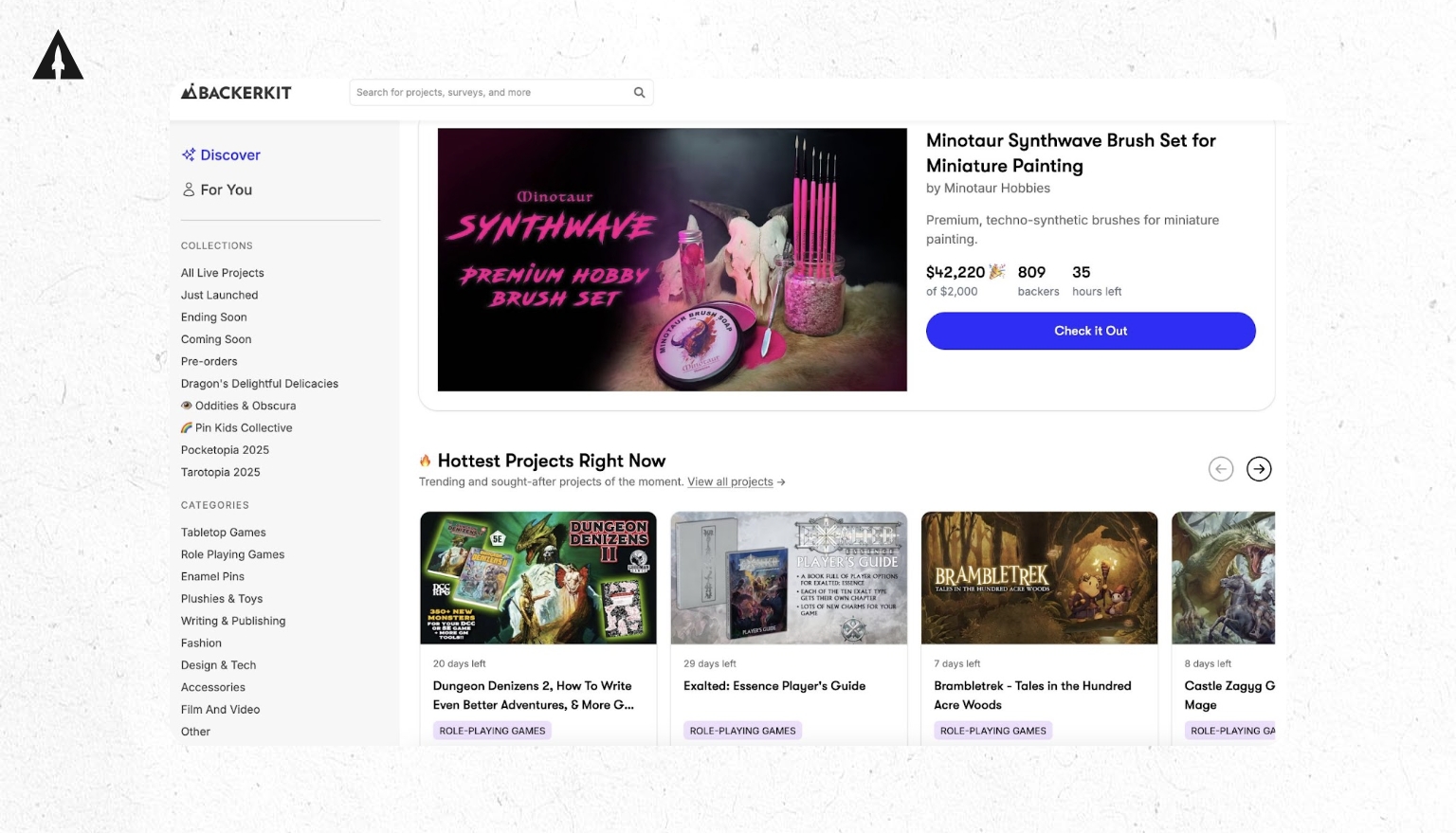
Newsletters
All three platforms boast big newsletters and are very actively sending out emails with new campaigns in them. Getting featured is definitely a plus.

Kickstarter again isn’t something that you can pay for or negotiate your way into. Gamefound’s can be negotiated if you sign up for their marketing services. And BackerKit is the same as Gamefound.
It seems like they all have some offering in each of the categories. I’m really interested to see how good AdFound ends up being. In the last 12 years of being in advertising, every automated tool I’ve ever seen for advertising has never lived up to the hype, but I’d love to be proven wrong.
Plus, I’m really curious how creators will like it that they won’t be advertising through their own Facebook account when using AdFound. Another thing is that I’m guessing that because Kickstarter has more traffic and a bigger backer database, stuff like homepage placement and their newsletter may have more potential than the other platforms.
5. Pre-Launch Features: Setting Up for Success

Let’s now look at all the tools the platforms have to help creators before they launch. The most important feature, which they all have, is the ability to collect pre-launch followers on the platform. But how they allow you to do that and the extra features they have to complement that core feature are all a bit different.
Kickstarter’s Pre-Launch Pages
Kickstarter’s Pre-Launch pages got a bit of an upgrade in 2024. It used to be very simple, and all you could change was the project title and main image; now the editor has gotten a bit more powerful. Pages can be customized a lot more and made a lot longer.
For example, here’s the pre-launch page from our client, Punch Bowl:
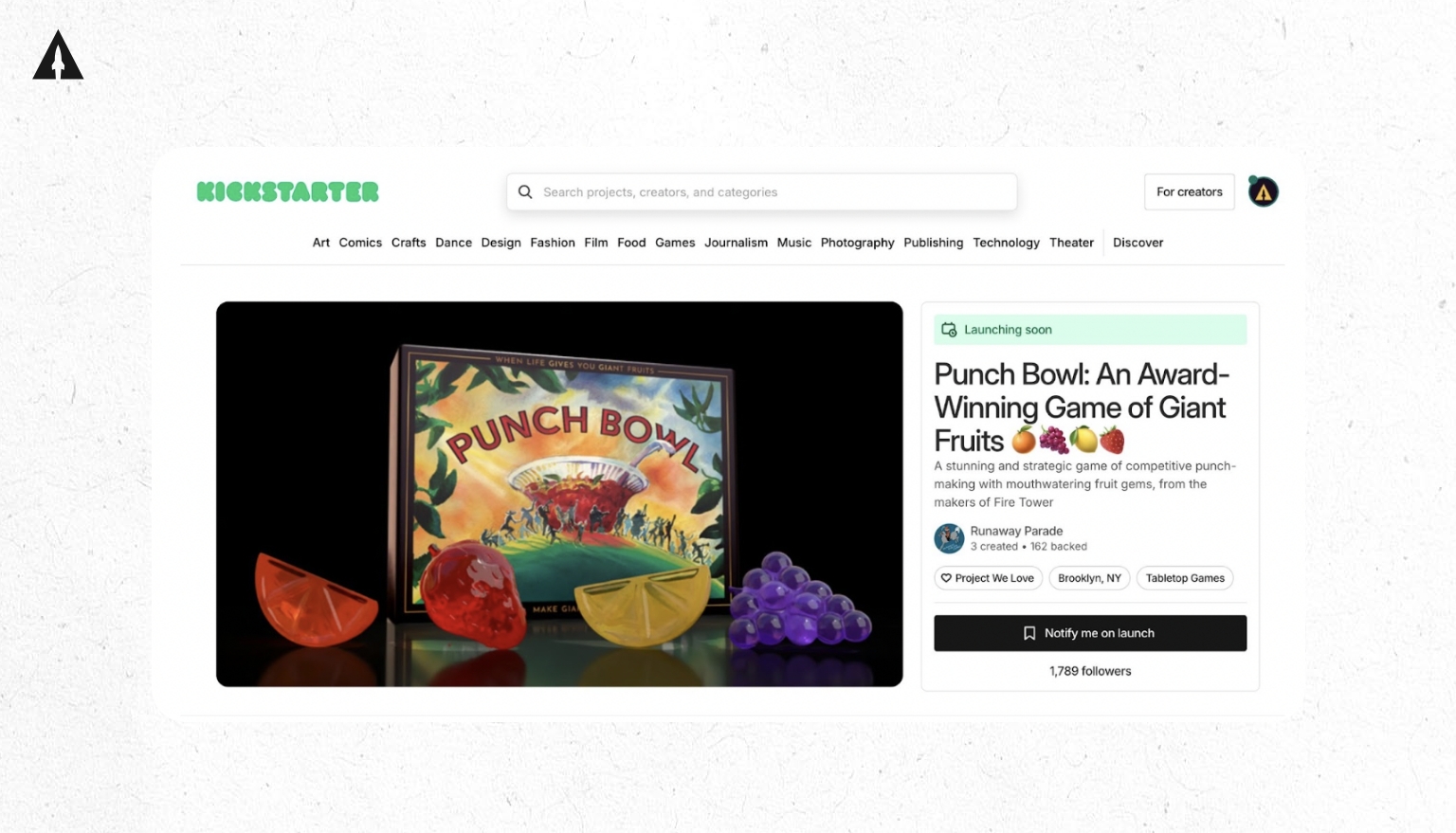
The only call to action available with Kickstarter pre-launch pages is for someone to follow your campaign. To follow the campaign, the person has to create a Kickstarter account, which is both good and bad.
Starting with the bad, people that don’t have Kickstarter accounts may not go through the trouble to create one if they just have a little interest in your project. The good: if they do create one or log in and follow your project, they are much more likely to follow through with the purchase.
Kickstarter will send out 3 notifications to your followers at pre-set times:
- One when you launch
- One 48 hours before your campaign ends
- One 8 hours before your campaign ends
These notifications are not customizable, and also you cannot download your follower list. Lastly, Kickstarter pre-launch pages are discoverable on their platform, which helps draw more interest to your project.
Gamefound’s Pre-Launch Approach
Like Kickstarter, Gamefound allows you to create a pre-launch page. It’s also customizable, but quite a lot more than Kickstarter. It uses the campaign page editor, so it basically feels like the campaign page.
The call to action is the same as Kickstarter: to get a follower to the campaign. Like Kickstarter, people must have a Gamefound account to follow, they’ll send the notifications automatically to followers, and the follower list can’t be downloaded.
A feature that Gamefound has that Kickstarter doesn’t is that you can add something called a “follower gift.” Essentially an incentive for someone to follow your campaign. For example, you can offer an automatic discount or a free add-on if they follow your campaign in the pre-launch and then back your campaign when it’s live.
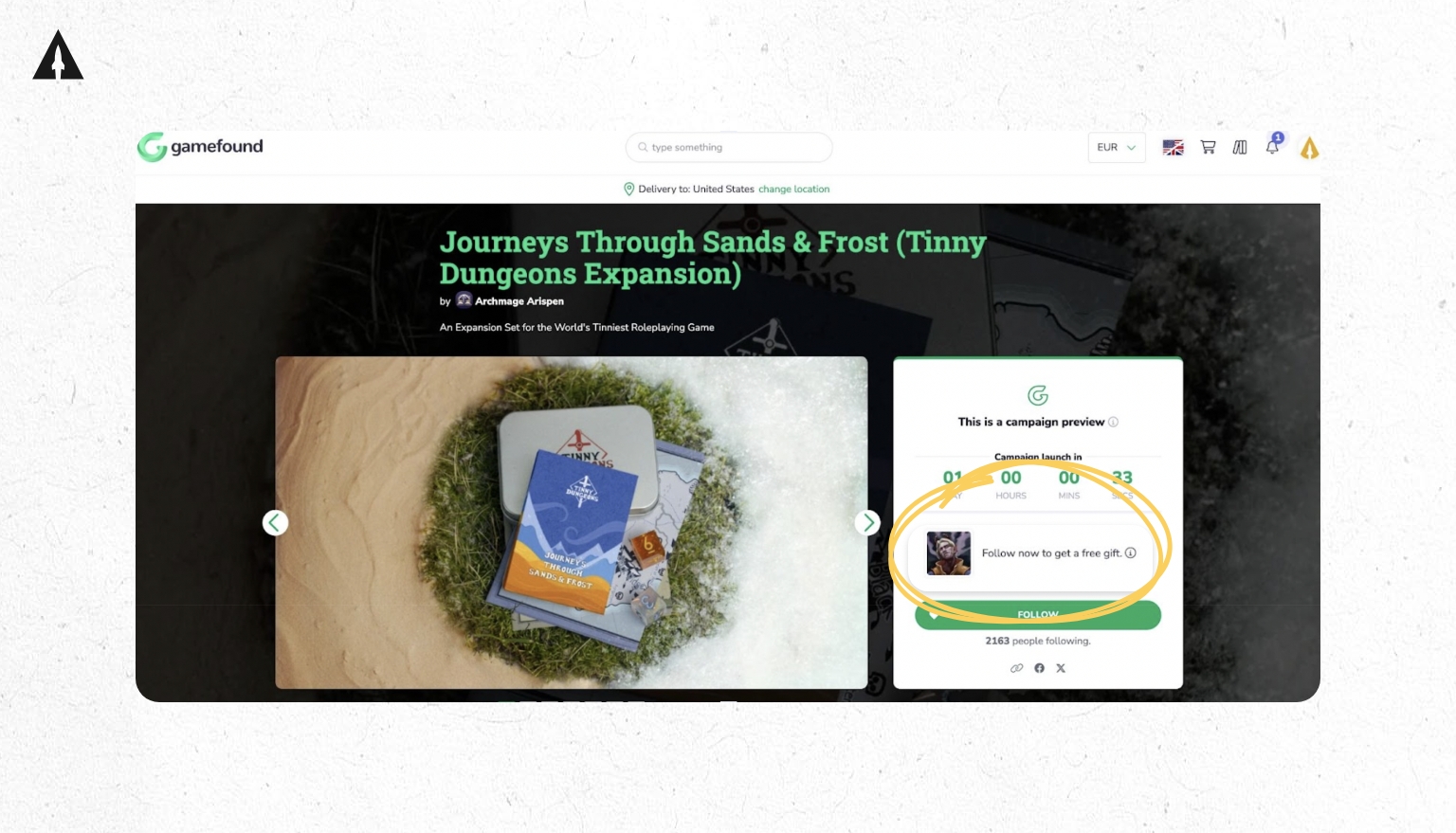
Another feature they have is commenting, updates, and FAQs. Like I said before, the pre-launch page basically is the campaign page but in preview mode, meaning stuff like comments can be accessed before the campaign launches. This is a really cool feature because it allows followers to start chatting with the creator and other backers prior to the launch.
BackerKit’s Teaser Pages
BackerKit also has a pre-launch page that they call teaser pages. Again, it’s customizable. Where they differ from Kickstarter & Gamefound is that they ask for an email opt-in or for someone to follow with their BackerKit account.

I think this call to action is the best of the three platforms because it’s the best of both worlds: asking for an email is often a better CTA at this stage, and if people want to create an account, they can too.
They continue to differentiate from Kickstarter and Gamefound by giving creators basically full customizability over the email notifications and the ability to download the follower list.
BackerKit also has something called Launch Party, which I like to think of as a “teaser page on steroids.” Basically, it’s a way to turn your teaser page into an event leading up to your launch. You can add a countdown timer, polls, updates, discussions, and connect your live stream directly to the page.
In terms of pre-launch features, BackerKit seems to win here. They have more features built-in that I think the other platforms should take note of. But will they continue to offer better features when it comes to the live campaign?
6. Live Campaign Features: Tools During Your Active Campaign
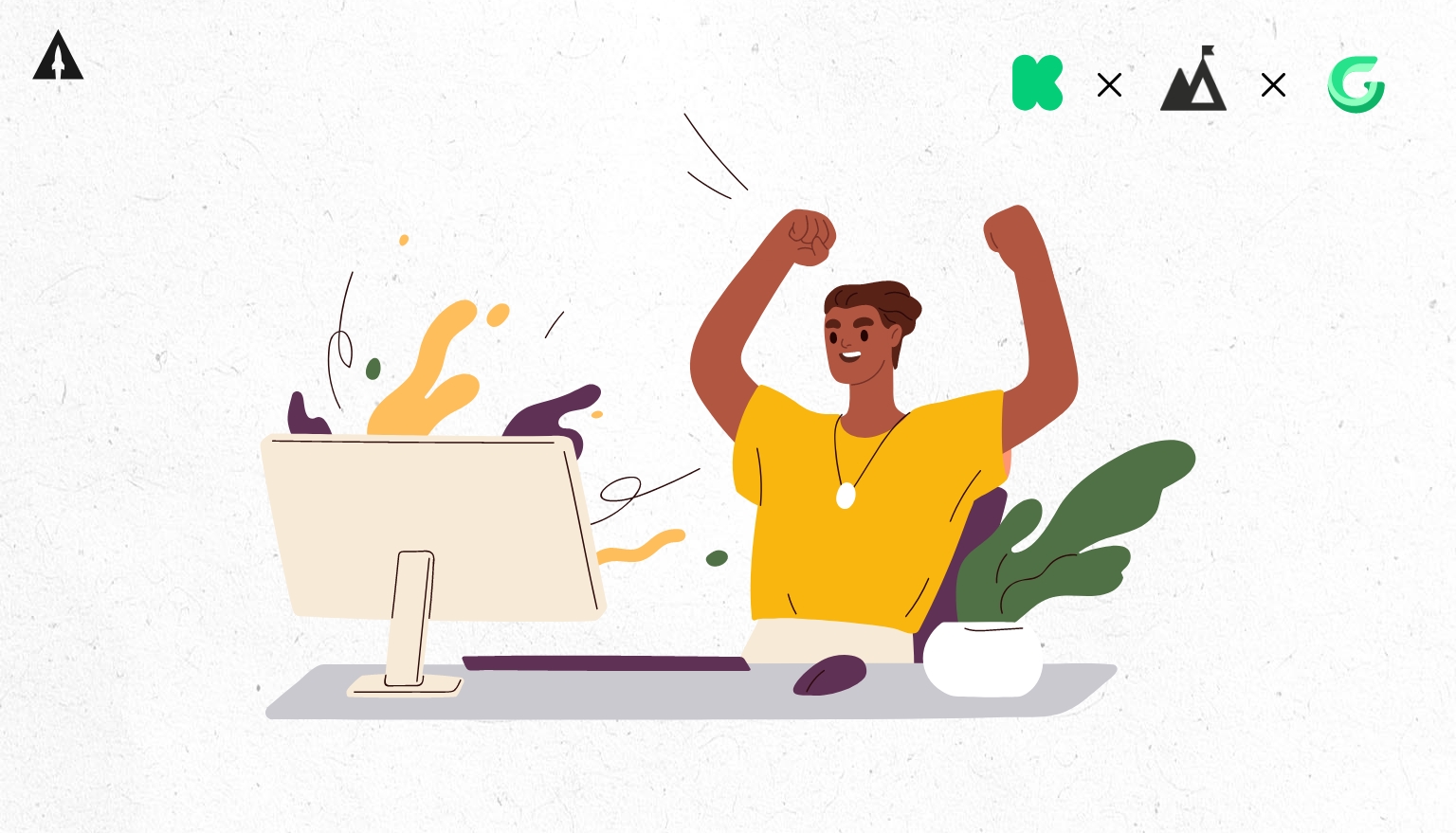
Now we’re putting the microscope over all the features that support your campaign while it’s live. Here’s where the list of features offered by the platforms starts getting pretty big. Because I don’t think anyone wants to sit through an exhaustive list of every feature, I’m going to give a high-level overview of the core features they each have and then get into some of the unique features they offer.
Core Features Comparison
Let’s start by comparing the basic features that every crowdfunding platform has: campaign page editors, communication tools, and rewards & add-ons.
Campaign Page Editors
All three have fairly customizable editors that are pretty easy to use. There isn’t a massive difference here.
Communication Tools
Each platform has threaded commenting and campaign updates. Kickstarter is the only one that allows for direct messaging between the backer and the creators directly on the platform.
Rewards & Add-ons
Again, the core functionality is quite similar. On all platforms, you can add different rewards & add-ons. On BackerKit, only a single reward or add-on can be added to a backer’s pledge. Kickstarter only allows you to add a single reward, but you can increase the quantity of add-ons in your cart.
Gamefound does both and operates more like a typical e-commerce website, which I like. For example, you can change the quantity of a reward on Gamefound campaigns. This is more a typical UI that online shoppers are used to.
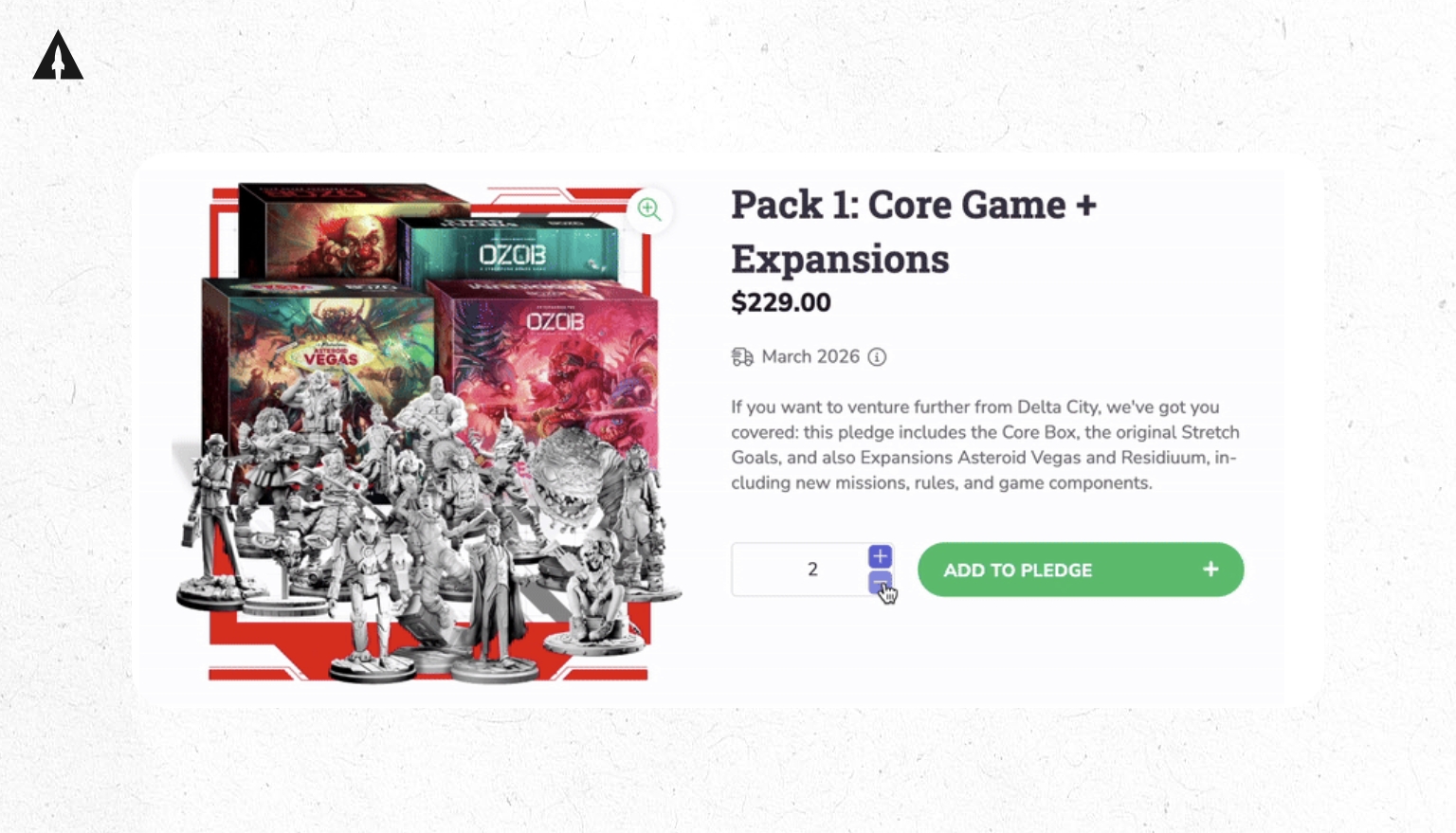
Another difference exclusive to BackerKit and now more recently Kickstarter are “secret rewards” (called hidden rewards on BackerKit). This basically allows creators to share exclusive rewards with certain people. Here’s a guide I made on how to use Kickstarter secret rewards effectively.
This is something that another highly popular crowdfunding site, Indiegogo, has had for a long time and is one of my favorite features about that platform, so it’s cool to see it on BackerKit & Kickstarter.
Platform-Specific Features
Now let’s get into some of the core differences between the platforms.
Gamefound’s Game-Focused Interface
Because Gamefound is only focused on games, they designed a specific user interface to call out some important game information that applies to pretty much every campaign.
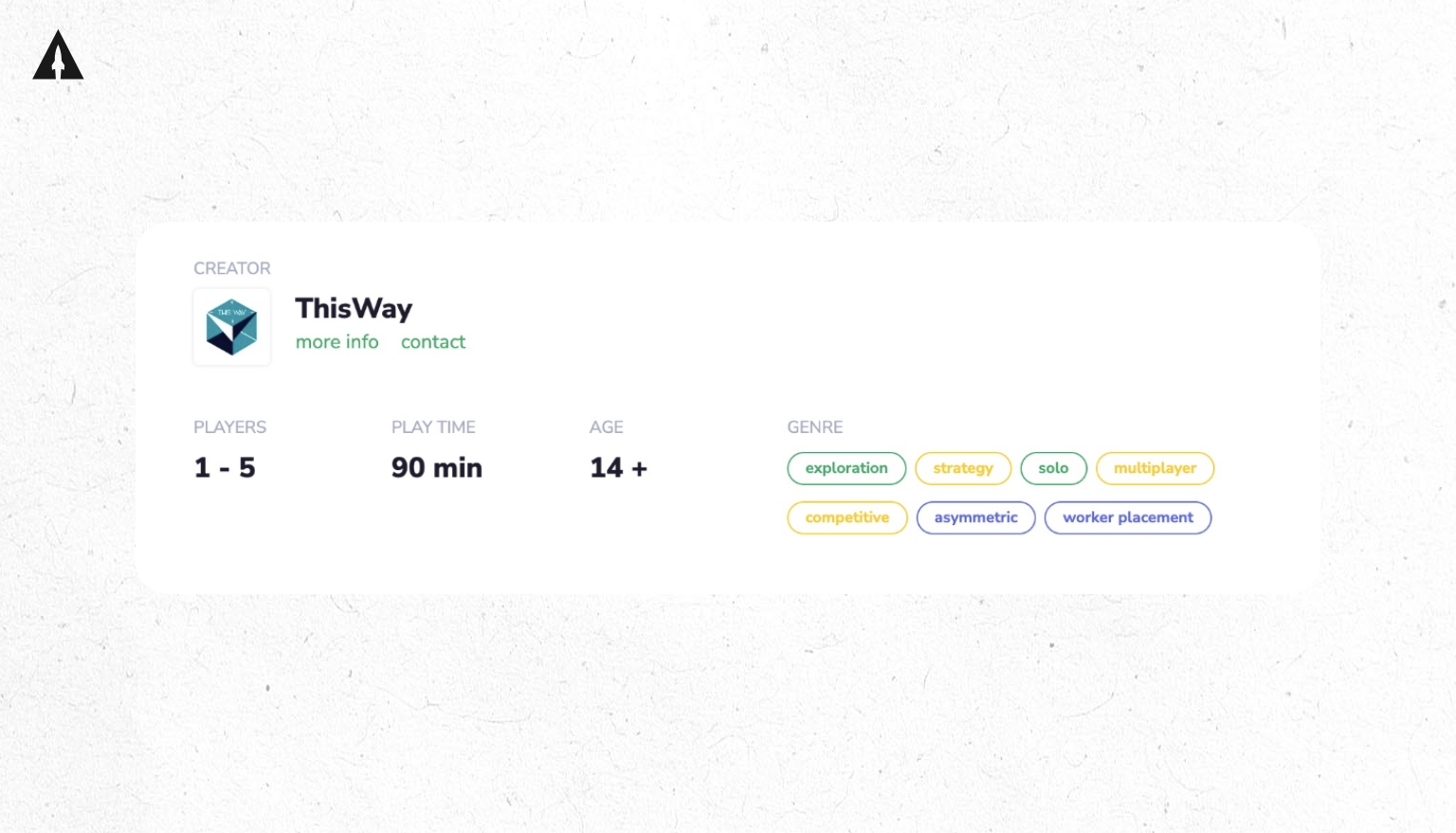
Info like number of players, playtime, age, and genre have a special section at the top of the page. Stretch goals are given their own section, and the next available one displays at the top after the funding goal is reached. Lastly, creators can add different translations of their campaign page for backers to choose from.
BackerKit’s Feature-Rich Experience
They have quite a lot of unique features:
Incentives
Like the name suggests, these are optional incentives you can add to your campaign for two different segments:
- First, 48-hour backers. If someone backs within 48 hours, a special incentive like an add-on will automatically be added to their pledge.
- Second, returning backers. You can upload your list of previous backers and give them a special incentive for backing your latest campaign.
Polls
You can ask backers questions and create polls as a fun way to get information and foster engagement.
Achievements
This is their version of Stretch Goals. They have a few different ways for achievements to be unlocked:
- Pledge count/funding goal achievements, where something is unlocked by hitting a certain backing amount
- Action achievements, where something is unlocked if a certain amount of clicks happen on a CTA
- Manual achievements, where something is unlocked based on the creator’s discretion
- Social share achievements, where something is unlocked pretty much the same way as action achievements
Streaming
You can hook up your Twitch, YouTube, or Moonbeam live stream to your campaign page.
Cross-Colab
A really unique feature where you collaborate with another live campaign and offer an incentive to back both campaigns. If the funding goals are reached and a backer pledges to both campaigns, they can unlock this exclusive cross-colab reward.
Overtime Mode
A really fun feature where if someone backs the campaign in the last 10 minutes, the campaign will be extended for another 10 minutes and activate Overtime Mode. The campaign will stay live until it doesn’t get a pledge for 10 minutes.
In terms of features being offered alone, I’d say that BackerKit wins this round. They seem more willing to test out new and innovative features. But let’s see if they keep the innovation going in our next category, post-campaign features.
7. Post-Campaign Features: Managing After Funding
We made it to the final round. It’s time to talk about all the features the platforms offer that make the post-campaign easier.
If you remember from the brief history lesson I gave at the beginning, both BackerKit and Gamefound started as software specifically for the post-campaign. So I’ll start off by saying that they have much more mature feature-sets for the post-campaign than Kickstarter. But with that said, Kickstarter has started to release useful post-campaign features lately.
Late Pledge
Let’s start with a feature that they all have and is incredibly important: Late Pledge. If you turn this on, this allows backers to continue to pledge to the campaign even after the campaign ends. Any additional pledges will be added to the total amount that you raised on your campaign.
For example, here’s the Late Pledge page for our client, Moonsoon, who raised $465,324 on their Kickstarter campaign and an additional $28,473 through Late Pledge:
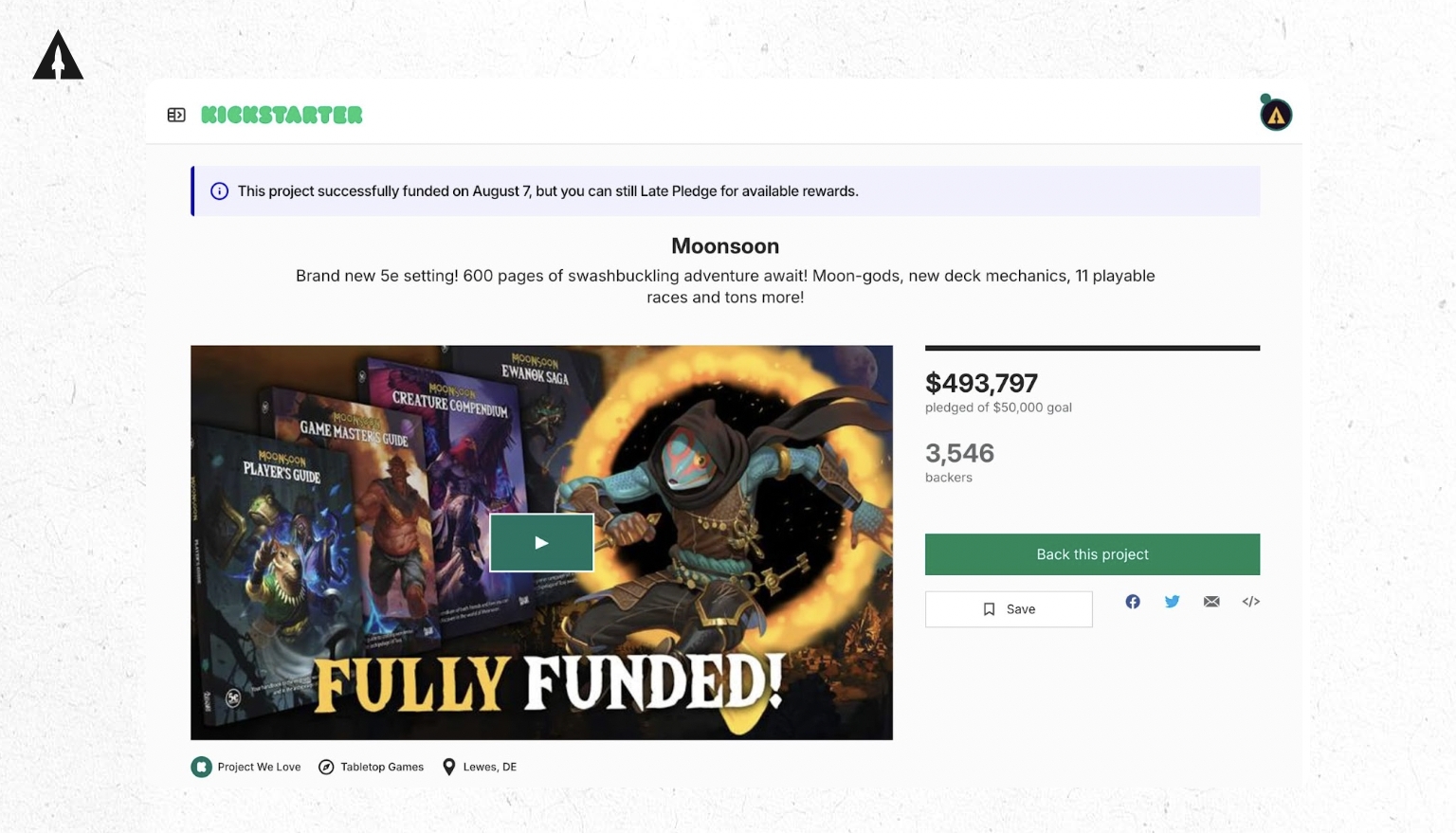
Kickstarter released this feature in 2024, and it’s been very popular. Now Kickstarter creators don’t have to use BackerKit or Gamefound if they want to set up a late pledge store.
Pledge Management
Kickstarter doesn’t have a robust pledge manager like Gamefound & BackerKit yet… but they just announced that their own pledge manager is coming in 2025. Currently, they have a feature called Surveys which can be thought of as a stripped-down pledge manager.
Even though it’s less feature-rich, if you have a relatively small project, say less than 100 backers, using Kickstarter’s survey tool may be worth it because there’s no fee to use it, and it keeps everything in the same platform. But if you are looking for something more robust, BackerKit & Gamefound’s pledge managers are currently much better.
So now let’s take a look at some of the key differences between these two pledge managers.
Cost Comparison
Assuming your project launched on BackerKit or Gamefound, there is no upfront cost to use the pledge manager. They do charge a fee of the funds raised through the pledge manager, though. For Gamefound, it’s 5%, and on BackerKit, it’s 3.5%.
Taxes and VAT
Both have robust tools for helping to collect tax, but Gamefound goes a bit further. They will actually settle EU VAT for creators. There are some important details to how this works that I’m not going to go into now, but you can check out their help article on the subject.
Backer Support
If one of your backers has a question during the pledge manager, BackerKit will actually act as the first line of defense. They claim that they answer 90% of backer questions for you, and the ones they can’t answer, they’ll forward to you. Gamefound doesn’t currently offer this.
Pre-order Stores
Both platforms have pre-order stores which are pretty similar functionality-wise to late pledge, but the UI changes a bit and looks more like a store, especially in the case of BackerKit. For example, here’s what the pre-order store for our client, SEA BEASTS, looks like on BackerKit:

There are quite a lot of other features that each of them have, but I will say in researching this article, BackerKit does have more extensive features and documentation on those features, making it easier to learn.
So clearly, BackerKit and Gamefound are currently way better than Kickstarter when it comes to post-campaign features, but is that reason enough for a creator to choose one of those platforms over Kickstarter?
I don’t think so.
Even if you launch on Kickstarter, you can still use BackerKit or Gamefound for your pledge manager, so you aren’t really missing out on those features if you choose to launch there. Plus, like I said before, Kickstarter will be launching their own pledge manager soon, so by the time you’re reading this article, it may already be live.
Conclusion: Making the Right Platform Choice

After diving deep into these seven categories, let’s summarize the key strengths and weaknesses of each platform to help you make the best choice for your tabletop game campaign.
Kickstarter: The Established Player
👍Pros:
- Has a wide range of categories that perform well
- First-time creators tend to perform better here
- Has a very large and diverse backer community
- Strong built-in discoverability (20-30% of funding can come from the platform)
- Better for games with broad appeal (Heavy Strategy, Medium Light Strategy, and Cozy & Cute games)
👎Cons:
- Behind when it comes to innovative features
- The lack of a robust pledge manager is currently a significant drawback (though they’re working on it)
Gamefound: The Board Game Specialist
👍Pros:
- Preferred by more hardcore game hobbyists
- Genres appealing to this audience (Co-op, Campaign, and Miniatures) tend to have an edge over Kickstarter
- Their focus on games allows them to build features specifically for gamers’ needs
- They have robust features across pre-launch, live campaign, and post-campaign
- Offers unique payment options like PayPal and Stable Pledge
👎Cons:
- Their audience is smaller and less diverse than Kickstarter
- First-time creators don’t perform as well here
- Very concentrated success (4 creators make up nearly 50% of all funding)
- Heavy reliance on established creators who bring their own audiences
BackerKit: The Feature Innovator
👍Pros:
- RPGs are performing very well here
- Very innovative and robust features across pre-launch, live campaign, and post-campaign
- They have the best pledge manager
- Excellent pre-launch features (Launch Party, email collection)
- Unique live campaign features (Cross-Colab, Overtime Mode)
👎Cons:
- Too many categories being offered with many having very little volume
- Board game performance has dropped off substantially
- First-time creators don’t seem to perform as well here either
- Limited organic discovery (only about 4% of funding)
Final Recommendation
In spite of Kickstarter being behind the other two platforms in terms of features, it looks like it may be a better and less risky option for most creators in most categories—both beginners and veterans alike. The community and brand that Kickstarter has built since 2009 is incredibly powerful.
But with that said, the increased competition has only lit a fire under Kickstarter, which definitely benefits the whole space. Trying to truly disrupt an incumbent as large as Kickstarter is difficult, which is why I respect what both Gamefound and BackerKit are doing.
Now if you want any additional help choosing the right platform or just want to chat about your launch, reach out to us by clicking here. Tell us a bit more about your game and we can come up with a detailed launch plan.

![DOWNLOAD ALL THE DATA FOR FREE Want all the data we used to compare Kickstarter, Gamefound and BackerKit? Download it below. {{ include_custom_fonts({"Gotham":["Black","Black Italic","Bold","Bold Italic","Regular","Regular Italic"]}) }}](https://no-cache.hubspot.com/cta/default/9067418/interactive-189163002695.png)
